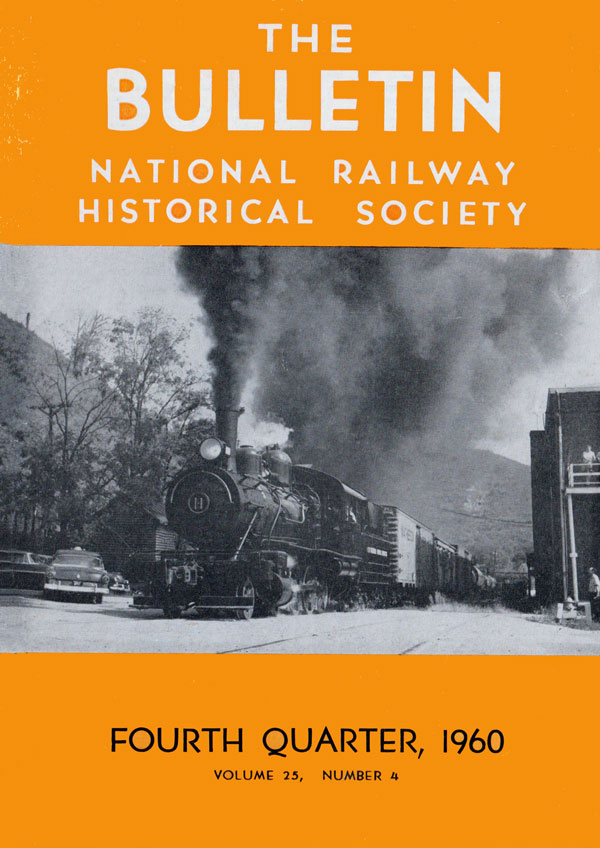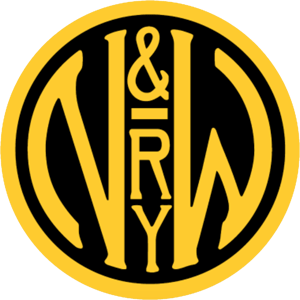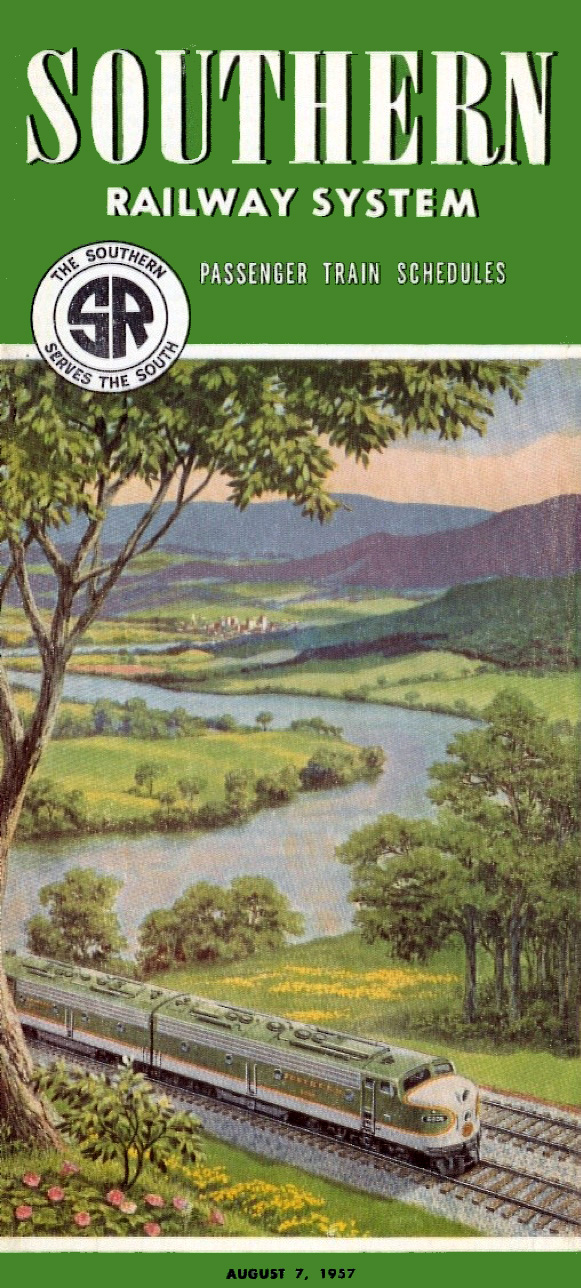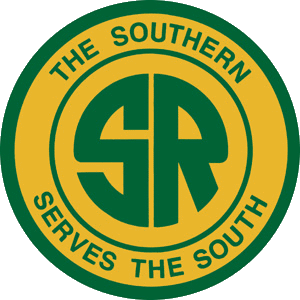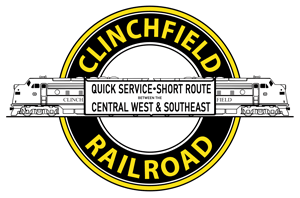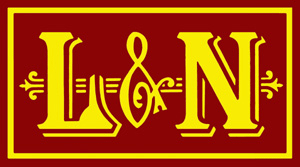
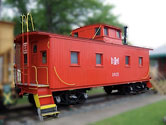




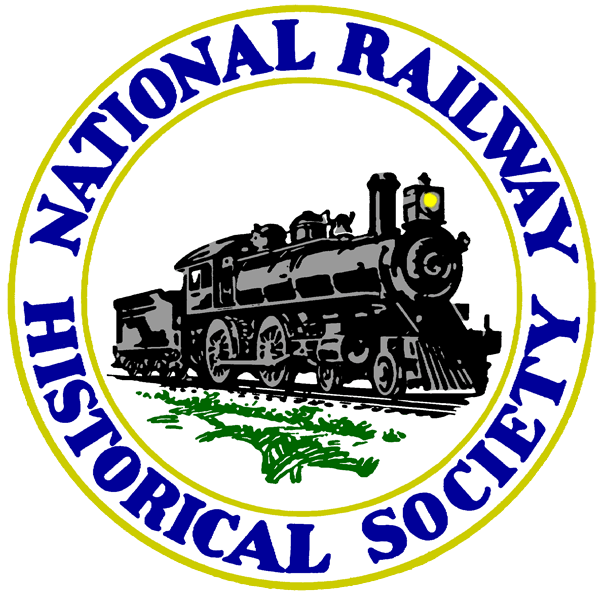 |
1960 Bristol ConventionNational Railway Historical Society |
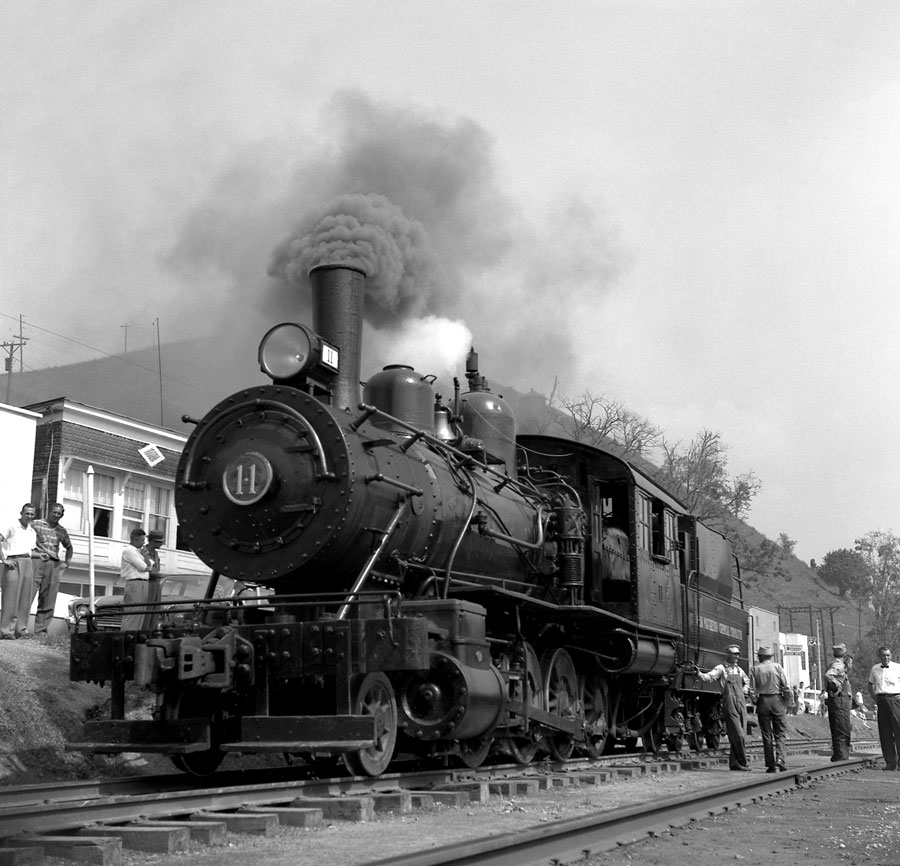
Saltville, Va / Sep 1960 / JCH

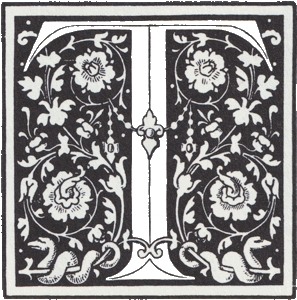 hanks to the host East Tennessee Chapter, and especially to Convention Secretary Steve Patterson, the Silver Anniversary Convention in Bristol, Virginia, was a bang-up one, and one that will be remembered by those of us who attended. Bristol, as all the world knows, is an important junction between the Southern and the Norfolk and Western Railways and lies along the important "in-land route" between the East and South. Both these roads cooperated to the fullest extent in making the convention a success.
hanks to the host East Tennessee Chapter, and especially to Convention Secretary Steve Patterson, the Silver Anniversary Convention in Bristol, Virginia, was a bang-up one, and one that will be remembered by those of us who attended. Bristol, as all the world knows, is an important junction between the Southern and the Norfolk and Western Railways and lies along the important "in-land route" between the East and South. Both these roads cooperated to the fullest extent in making the convention a success.
NRHS Bulletin / Fourth Quarter 1960
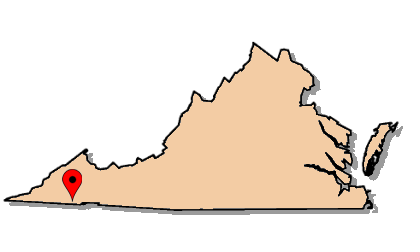
 he National Railway Historical Society held its 1960 annual convention in the railroad junction cities of Bristol, Tennessee and Virginia. Hosted by the East Tennessee Chapter, the 4-day event featured three different excursions conducted by the area's freight and passenger carriers. Saturday's trip featured steam on the Clinchfield Railroad's mainline to Kingsport by way of the Southern Railway to Johnson City. Sunday's long trip used diesels to travel up the Southern Railway's line from Bristol into the Virginia coalfields, along the Lousiville & Nashville's line over to Cumberland Gap, then by way of the Southern again down to Knoxville, with a nighttime return to Bristol through Johnson City. Monday's excursion featured a Norfolk & Western diesel trip northeast to Saltville, Virginia, where Olin-Mathieson Chemical brought out their ancient steamer for show. HawkinsRails' founder John Hawkins drove up from Pensacola, Florida, to participate in the convention.
he National Railway Historical Society held its 1960 annual convention in the railroad junction cities of Bristol, Tennessee and Virginia. Hosted by the East Tennessee Chapter, the 4-day event featured three different excursions conducted by the area's freight and passenger carriers. Saturday's trip featured steam on the Clinchfield Railroad's mainline to Kingsport by way of the Southern Railway to Johnson City. Sunday's long trip used diesels to travel up the Southern Railway's line from Bristol into the Virginia coalfields, along the Lousiville & Nashville's line over to Cumberland Gap, then by way of the Southern again down to Knoxville, with a nighttime return to Bristol through Johnson City. Monday's excursion featured a Norfolk & Western diesel trip northeast to Saltville, Virginia, where Olin-Mathieson Chemical brought out their ancient steamer for show. HawkinsRails' founder John Hawkins drove up from Pensacola, Florida, to participate in the convention.
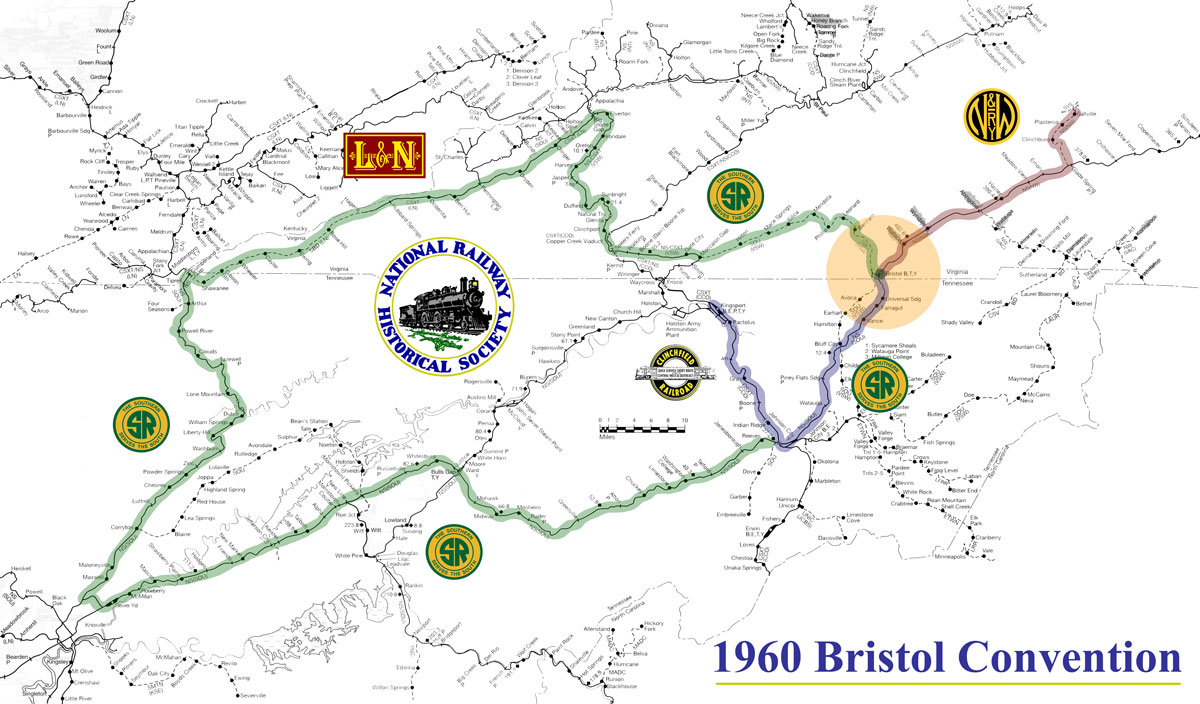
excursions map / RWH

See also these related scrapbooks:
- Norfolk & Western Railway in Fallen Flag Mainlines
- Southern Railway in Fallen Flag Mainlines
- Louisville & Nashville Railroad in Fallen Flag Mainlines
Friday
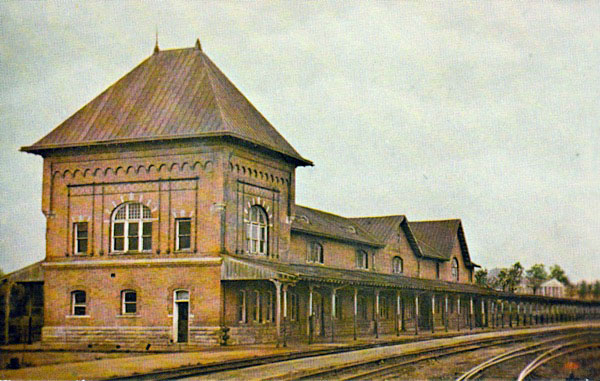
postcard / collection

collection

The N&W had set out, on a yard track adjacent to the station in a photogenic spot, diamond-stacked 4-8-0 engine 475, to provide the proper atmosphere for visitors. Convention activities began Friday afternoon and all day Saturday with registration on the mezzanine of the General Shelby Hotel, convention head-quarters, adjacent to the station.
NRHS Bulletin / Fourth Quarter 1960
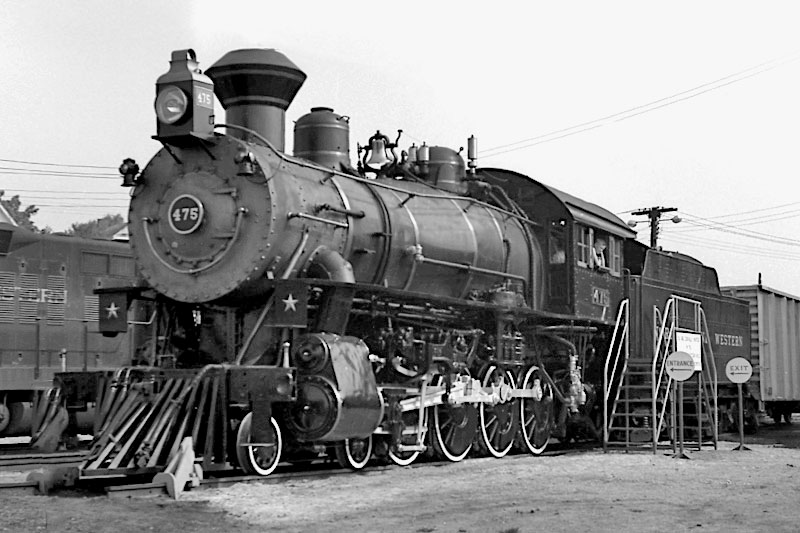
Norfolk & Western #475
Bristol, Va / Sep 1960 / JCH


Norfolk & Western #475
to Virginia Scrap Iron & Metal, Roanoke
to various private owners
to Illinois Railway Museum
to Boone & Scenic Valley Railroad
to Strasburg Railroad #475
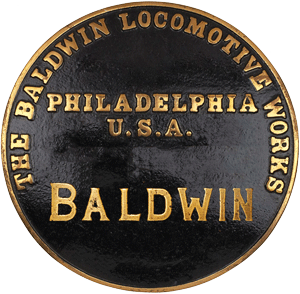
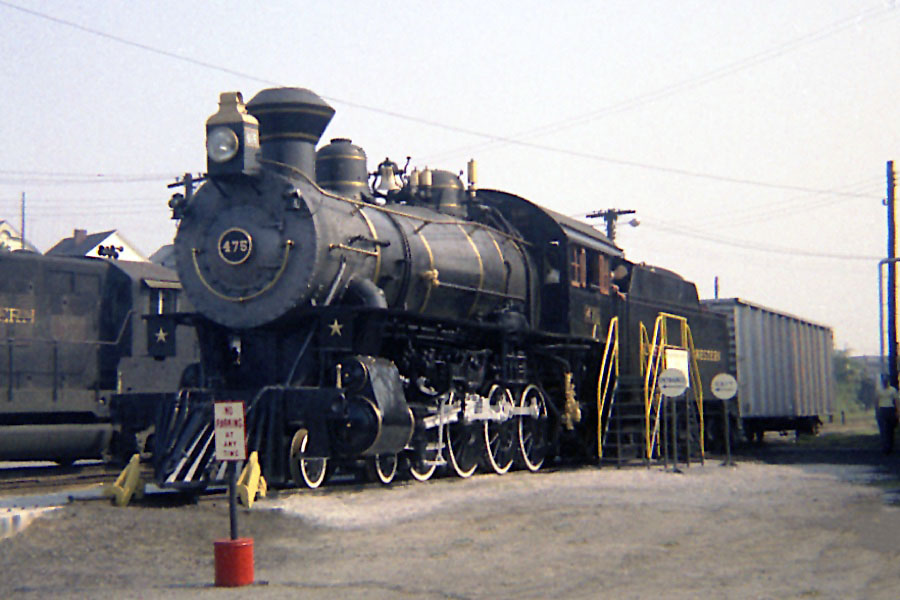
Bristol, Va / Sep 1960 / JCH

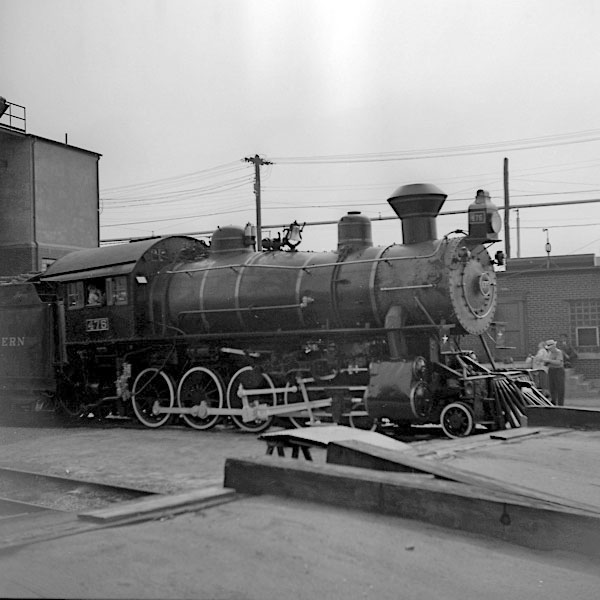
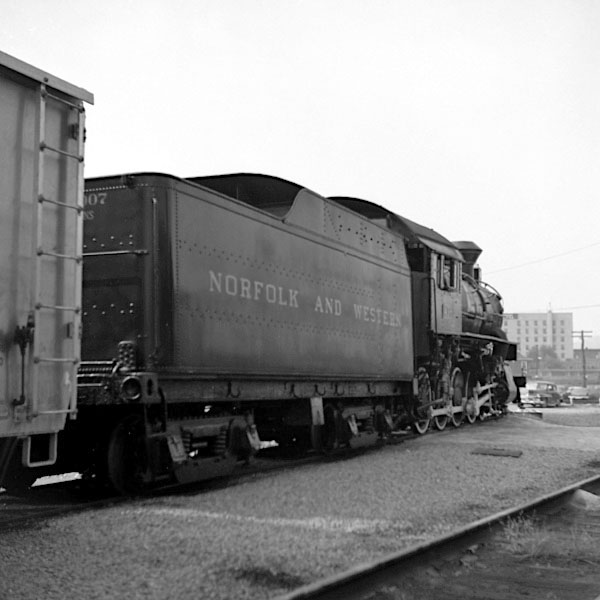
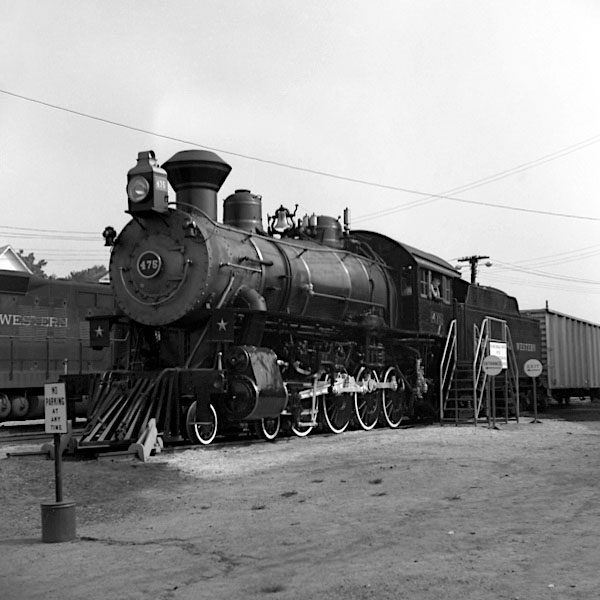
Bristol, Va / Sep 1960 / JCH
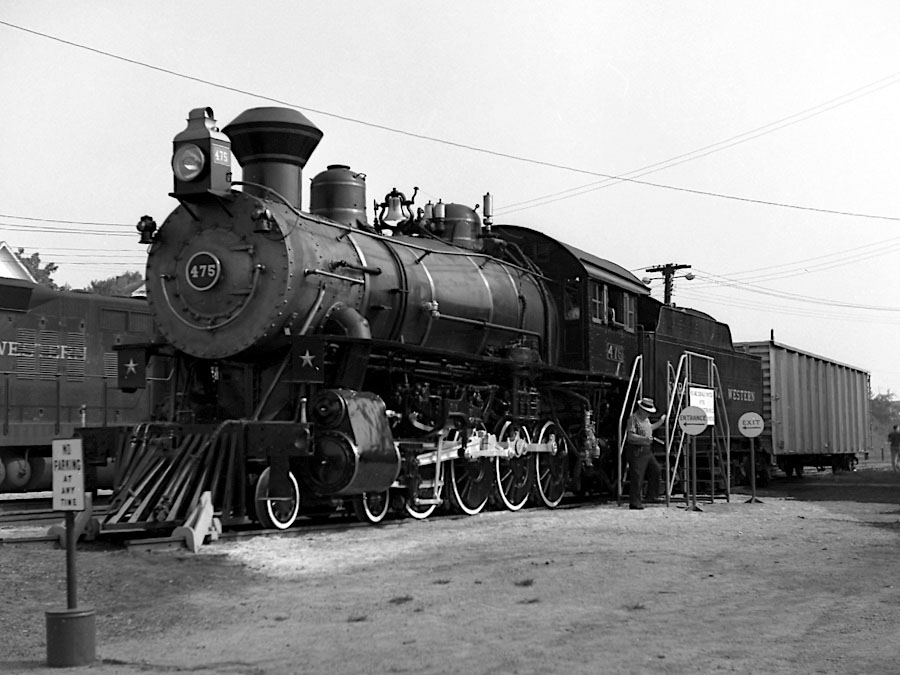
Bristol, Va / Sep 1960 / JCH
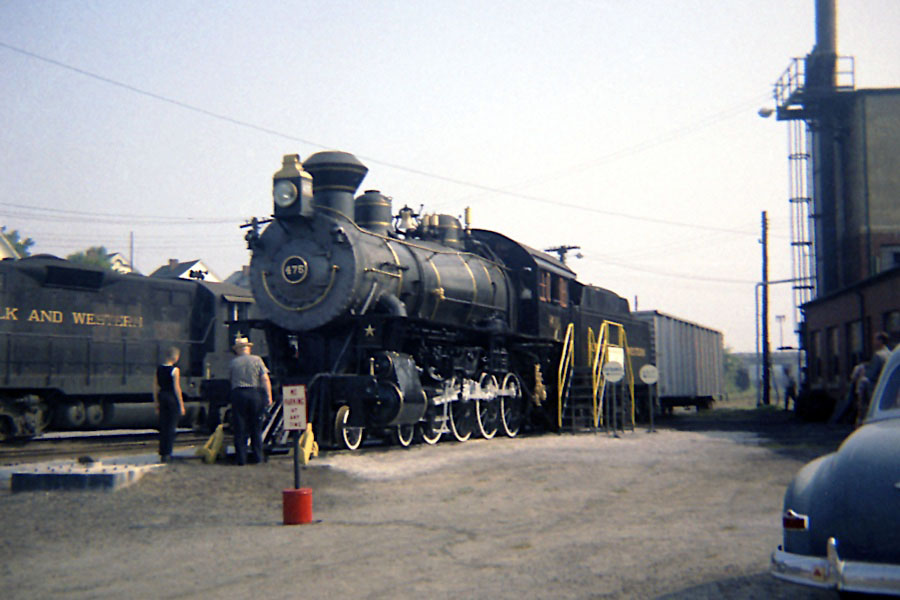
Bristol, Va / Sep 1960 / JCH

See also our complete Strasburg Railroad featured tourist scrapbook in Preservation
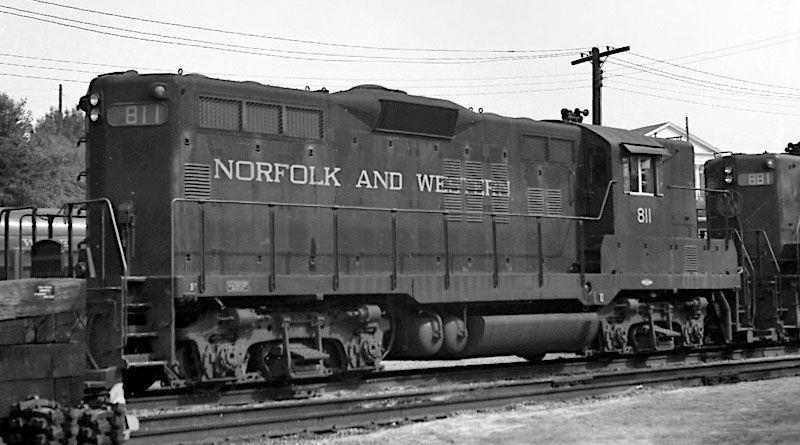
Norfolk & Western #811
Bristol, Va / Sep 1960 / JCH


Norfolk & Western #811

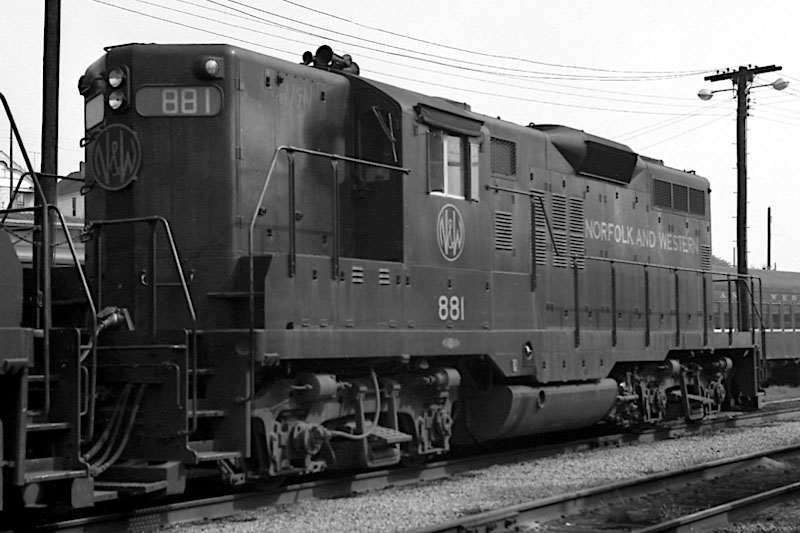
Norfolk & Western #881
Bristol, Va / Sep 1960 / JCH


Norfolk & Western #881
to Norfolk Southern #958 (road slug)

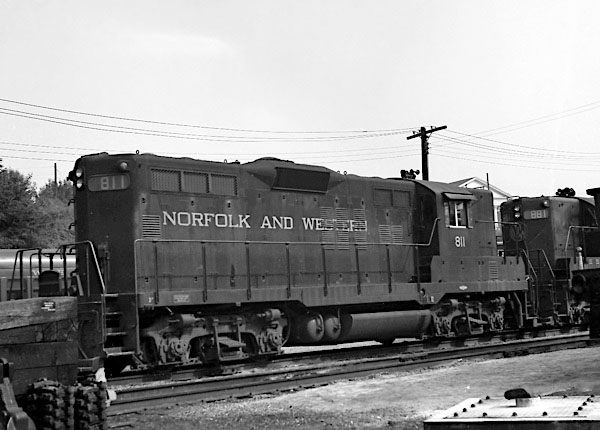
Bristol, Va / Sep 1960 / JCH

Bristol, Va / Sep 1960 / JCH

See also our complete Norfolk & Western Railway featured Fallen Flag scrapbook in Mainlines
Saturday

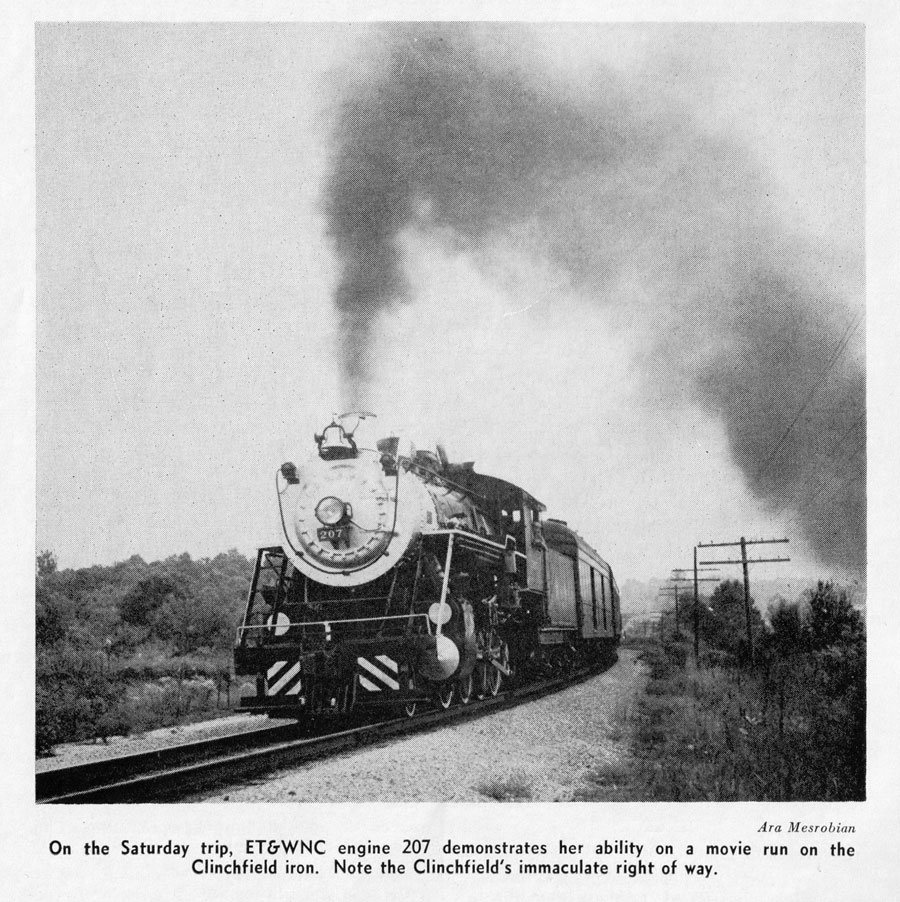 The first trip, on Saturday, featured East Tennessee & Western North Carolina steam over the main line of the Clinchfield. Our cars, all Norfolk and Western equipment — express car 129 and coaches 1647, 1669, 1705, 1663, 1628, 1655, and 1648 were put on the rear of Southern Train 41, the Pelican — a number of the delegates had come down on this train. While 41 cut off three head-end cars here, we were switched on the rear of the train. Arrived at Johnson City, Southern switcher 2278 pulled us into the Clinchfield interchange track, and Clinchfield switcher 358 took us into the former Clinchfield passenger station. Here we got our power for the trip over the Clinchfield to Kingsport — ET&WNC Consolidation 207. This engine is ex-Southern 630 and was built by the Richmond Works of the American Locomotive Company, according to her builder's plate, in February 1904. Also waiting for us were four Norfolk & Western gondolas, fitted with guard rails and seats - 99955, 99940, 90772, and 99166. There was a brief delay at Johnson City while we waited for Train 46, the Tennesseean, which was running late that day — it contained a sleeping car chartered by the Louisville Chapter, and they were to join our trip to Johnson City, the car to be set out at Bristol.
The first trip, on Saturday, featured East Tennessee & Western North Carolina steam over the main line of the Clinchfield. Our cars, all Norfolk and Western equipment — express car 129 and coaches 1647, 1669, 1705, 1663, 1628, 1655, and 1648 were put on the rear of Southern Train 41, the Pelican — a number of the delegates had come down on this train. While 41 cut off three head-end cars here, we were switched on the rear of the train. Arrived at Johnson City, Southern switcher 2278 pulled us into the Clinchfield interchange track, and Clinchfield switcher 358 took us into the former Clinchfield passenger station. Here we got our power for the trip over the Clinchfield to Kingsport — ET&WNC Consolidation 207. This engine is ex-Southern 630 and was built by the Richmond Works of the American Locomotive Company, according to her builder's plate, in February 1904. Also waiting for us were four Norfolk & Western gondolas, fitted with guard rails and seats - 99955, 99940, 90772, and 99166. There was a brief delay at Johnson City while we waited for Train 46, the Tennesseean, which was running late that day — it contained a sleeping car chartered by the Louisville Chapter, and they were to join our trip to Johnson City, the car to be set out at Bristol.
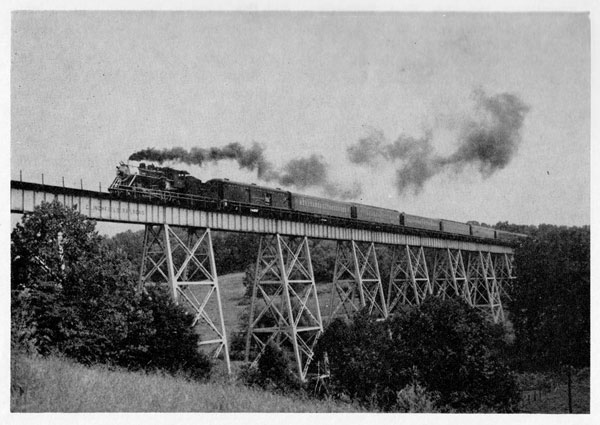 Powered by the 207, we proceeded up the Clinchfield main to Kingsport. For the benefit of photographers, two movie runs were made en route one on a high viaduct over Boone's Creek, the other at Gray, where a sweeping curve permits an excellent view of the train. At Fordtown siding, we met an indication of how busy this pike is — a 153-car freight, with four units pulling and three pushing. On the outskirts of Kingsport, the 207 backed the train on a siding near the East Tennessee Chapter's coach. This car, former Southern coach 4117, now renamed Patterson, has been completely repainted and redecorated, inside and out, and the interior embellished with various railroad scenes. Here box lunches with fried chicken were served to all. Meanwhile, the 207 and the baggage car continued into town to turn and take water. Then diesel switcher 355 showed up, assisted in making up the train, and we were off on the return trip. Another movie run was made, just south of Kingsport where the track emerges from a tunnel and crosses the Holston River on a high bridge. Awaiting us at Johnson City were two Southern A units — CNO&TP unit 6136 and AGS unit 6704 — and 1023, a Southern Railway coach used as a rider for the crew — and we returned to Bristol in time for the annual banquet. En route, a meet, just to make things interesting, was held with 45, the Tennesseean, at Piney Flats.
Powered by the 207, we proceeded up the Clinchfield main to Kingsport. For the benefit of photographers, two movie runs were made en route one on a high viaduct over Boone's Creek, the other at Gray, where a sweeping curve permits an excellent view of the train. At Fordtown siding, we met an indication of how busy this pike is — a 153-car freight, with four units pulling and three pushing. On the outskirts of Kingsport, the 207 backed the train on a siding near the East Tennessee Chapter's coach. This car, former Southern coach 4117, now renamed Patterson, has been completely repainted and redecorated, inside and out, and the interior embellished with various railroad scenes. Here box lunches with fried chicken were served to all. Meanwhile, the 207 and the baggage car continued into town to turn and take water. Then diesel switcher 355 showed up, assisted in making up the train, and we were off on the return trip. Another movie run was made, just south of Kingsport where the track emerges from a tunnel and crosses the Holston River on a high bridge. Awaiting us at Johnson City were two Southern A units — CNO&TP unit 6136 and AGS unit 6704 — and 1023, a Southern Railway coach used as a rider for the crew — and we returned to Bristol in time for the annual banquet. En route, a meet, just to make things interesting, was held with 45, the Tennesseean, at Piney Flats.
NRHS Bulletin / Fourth Quarter 1960
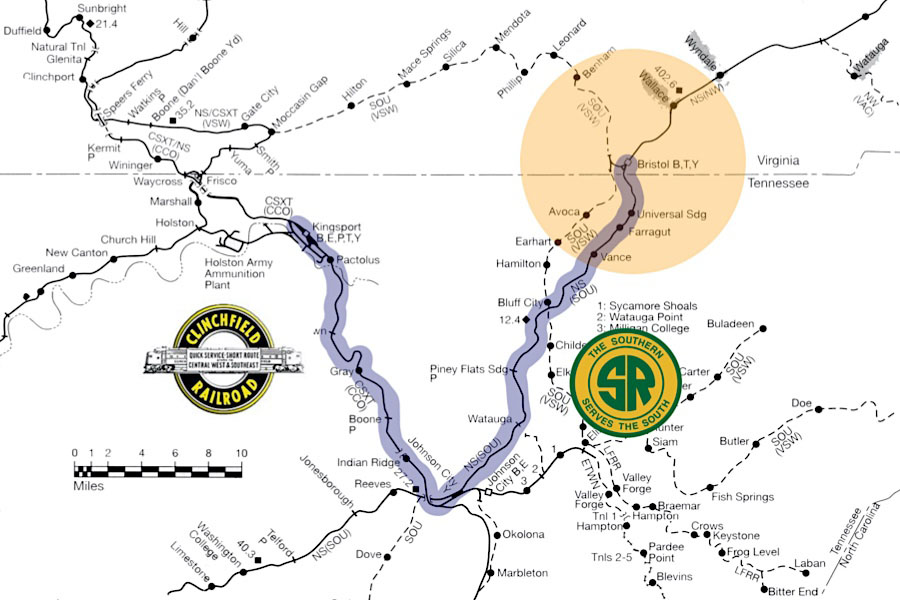
Saturday route map / RWH
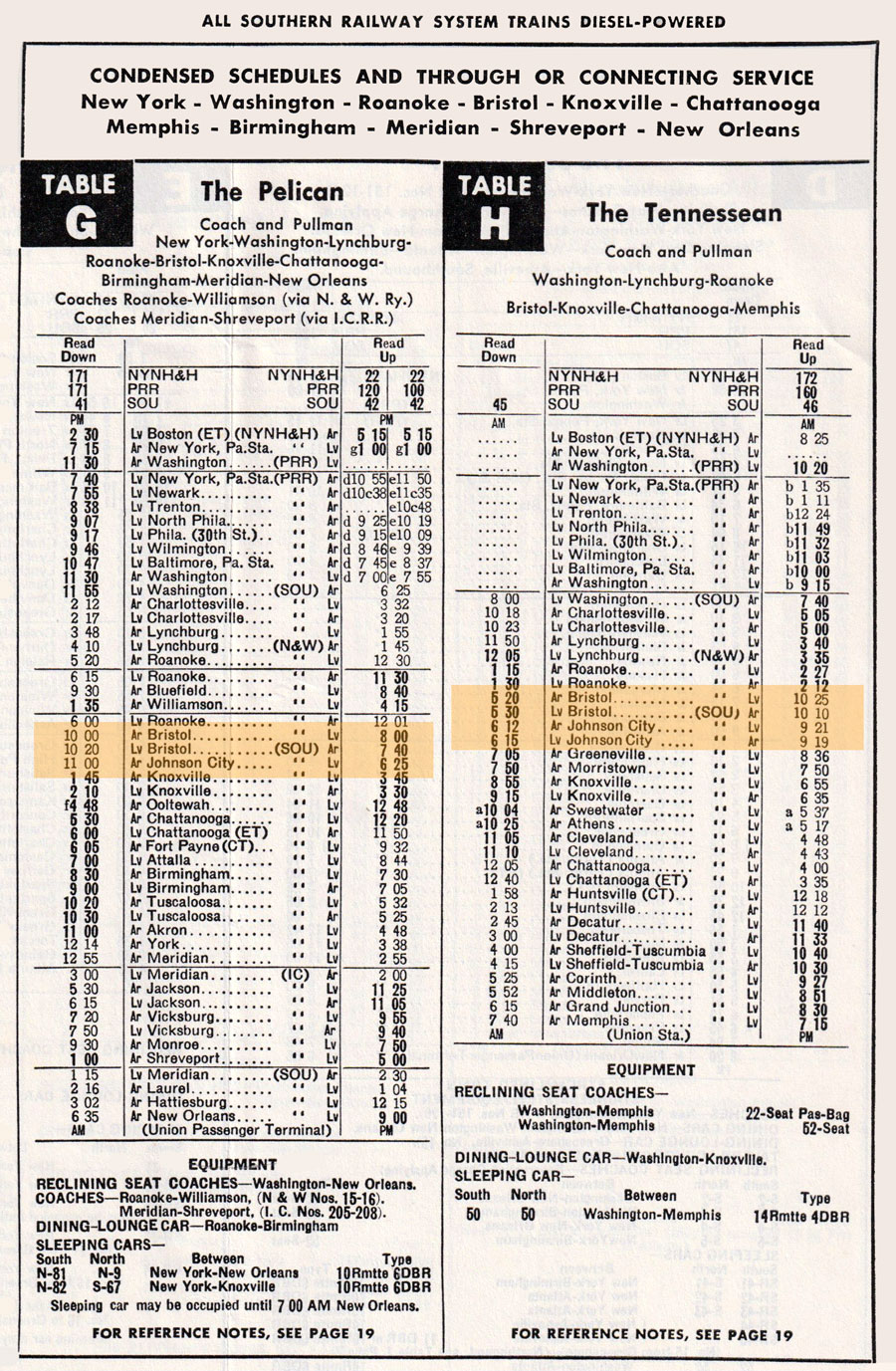
1959 Southern Railway timetable / collection

See also our complete Southern Railway featured Fallen Flag collection in Mainlines
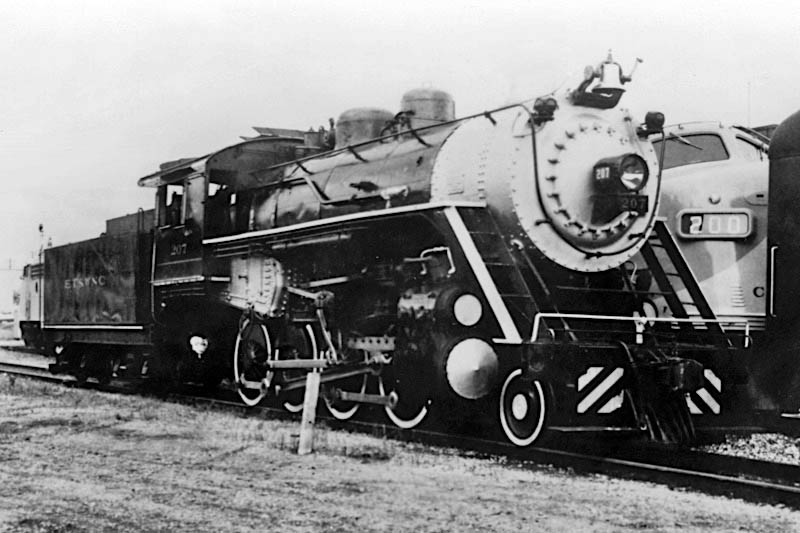
East Tennessee & Western North Carolina #207
Johnson City, Tn / collection


East Tennessee & Western North Carolina #207
to East Tenn & W N Carolina #207, 1952
to Southern Railway #630, 1968
to Tennessee Valley Railway Museum
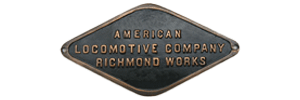
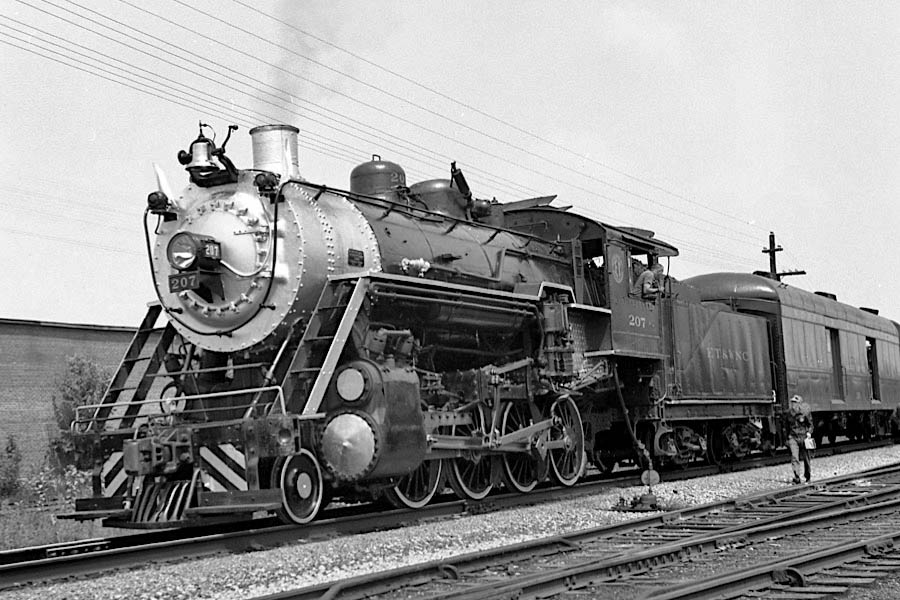
Johnson City, Tn / Sep 1960 / JCH
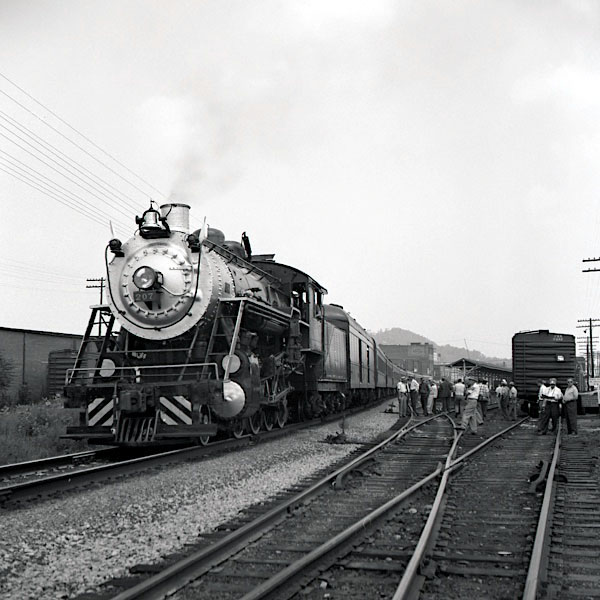
Johnson City, Tn / Sep 1960 / JCH

Gray, Tn / Sep 1960 / JCH

Sep 1960 / JCH
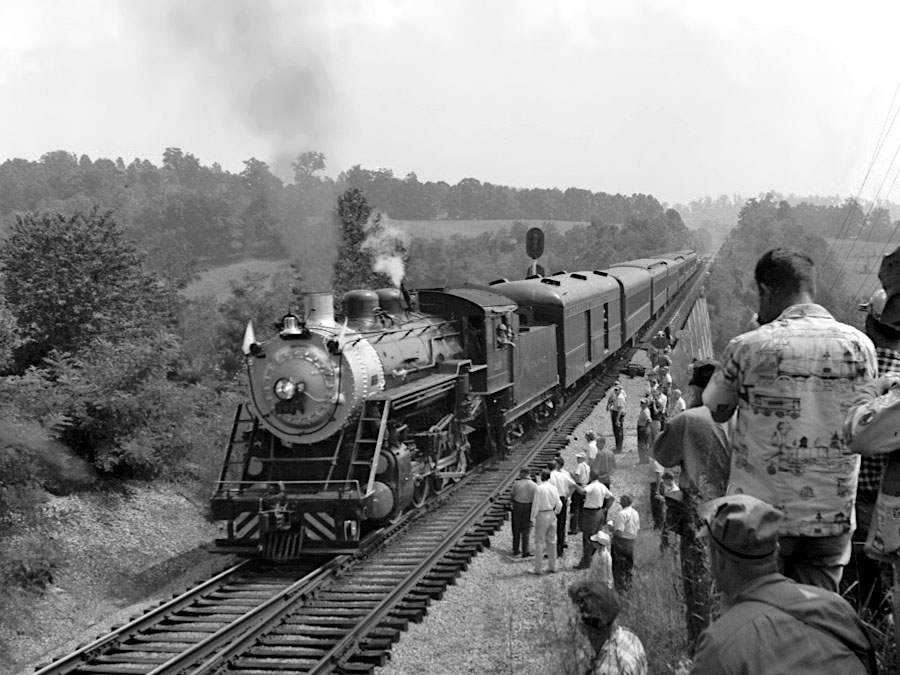
Gray, Tn / Sep 1960 / JCH
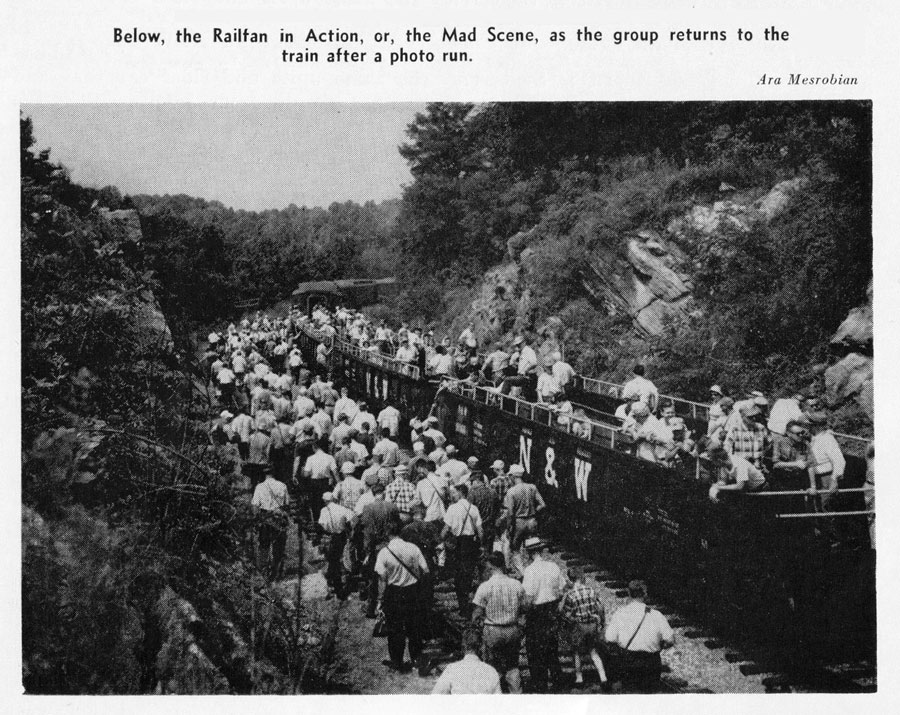
from NRHS Bulletin - Fourth Quarter 1960 / collection
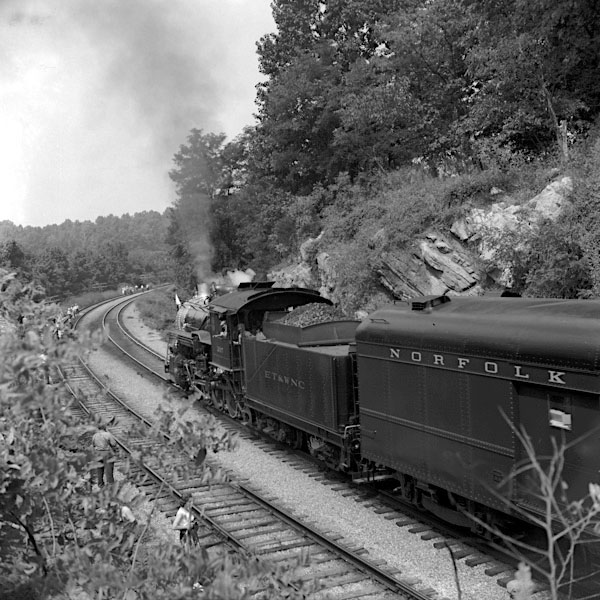
Gray, Tn / Sep 1960 / JCH

Kingsport, Tn / Sep 1960 / JCH
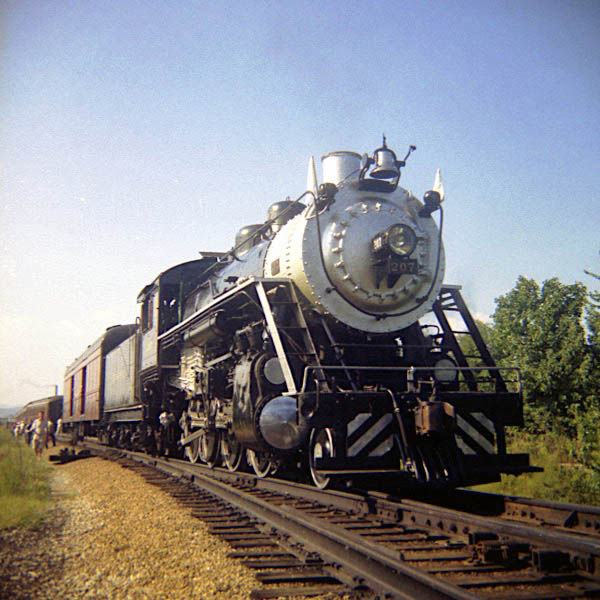
Kingsport, Tn / Sep 1960 / JCH

Kingsport, Tn / Sep 1960 / JCH

Kingsport, Tn / Sep 1960 / JCH

See also our complete East Tennessee & Western North Carolina Railroad scrapbook in Shortlines


Clinchfield Railroad #355
1 of 6 blt new for Clinchfield (350-355)


Kingsport, Tn / Sep 1960 / JCH
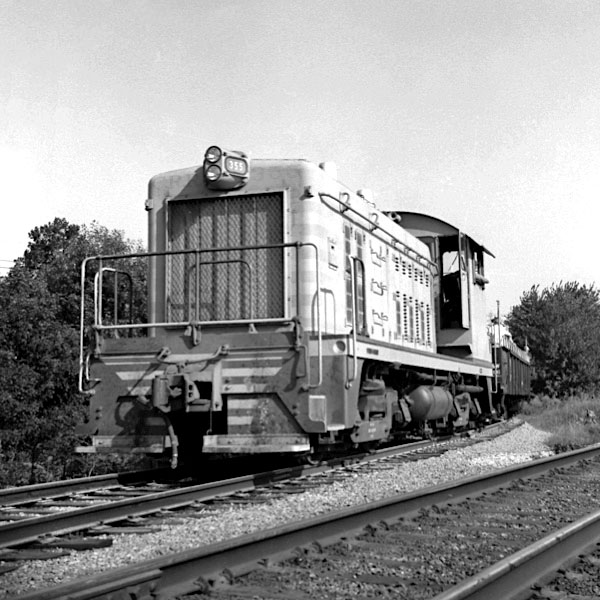
Kingsport, Tn / Sep 1960 / JCH
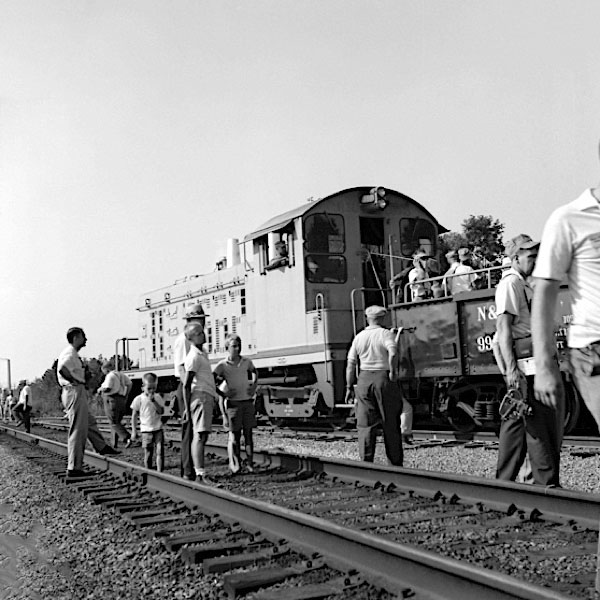

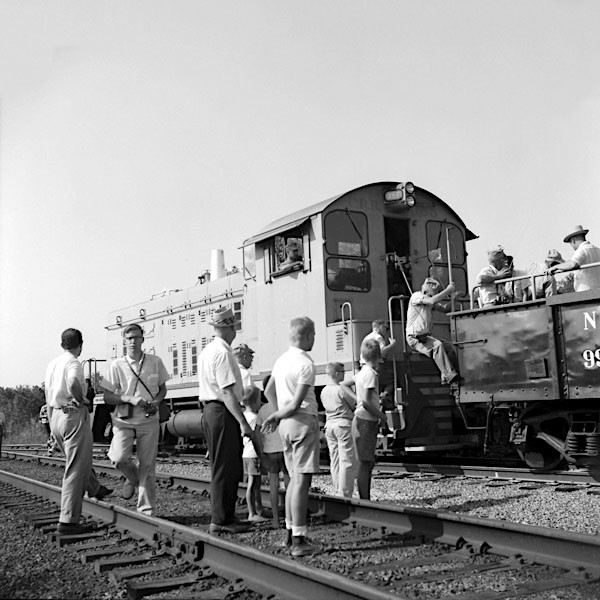

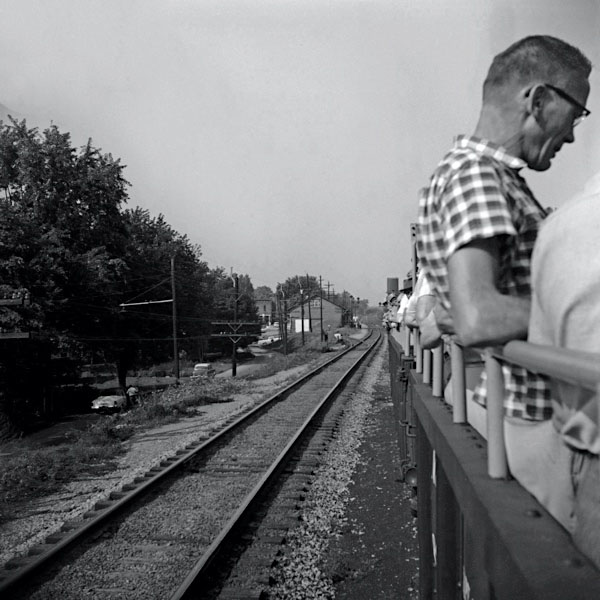
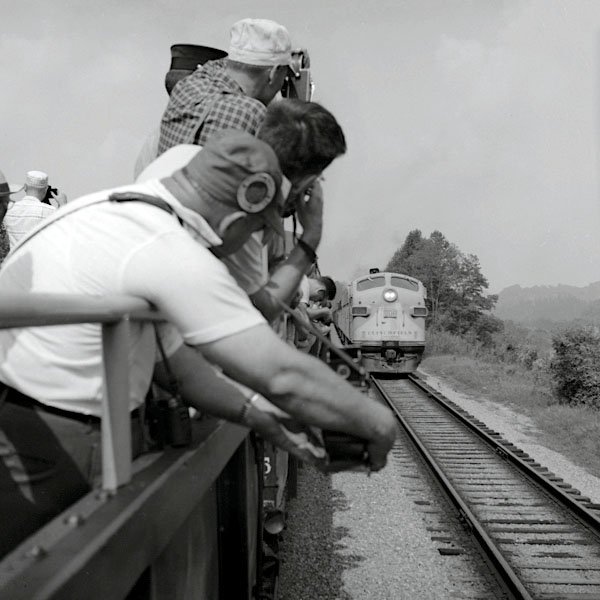
Kingsport, Tn / Sep 1960 / JCH
Sunday


The "Trail of the Lonesome Pine" trip on Sunday was one that will not soon be forgotten by those who were there, covering, as it did, many miles of track that have not seen a passenger train for many years. Our consist: A unit 4192, B units 4387 and 4389, A unit 4250 (all Southern); Southern heater car (to maintain the air-conditioning) HC-50; N&W express car 129, N&W coaches 1647, 1669, 1630, 1643; Louisville & Nashville diner 2790; Southern diner 3304 (named Alexandria); N&W coaches 1672, 1622, 1655, and 1648, and the four gondolas.
A switcher pulled us backwards and pushed us into the wye track, where the road units came on. Our route began up a Bristol street, but we soon found ourselves crossing scenic Moccasin Gap into Gate City. At this point is the junction with the branch to Bulls Gap, on the main line, used to carry Virginia coal from this area south. We paralleled the Clinchfield main line up the Copper Creek valley, and presently arrived at Natural Tunnel, our first photo stop. Many years ago, passenger trains made a ten-minute scenery stop here, similar to the Rio Grande's present custom in the Royal Gorge in Colorado; and the cameras took full advantage of it! From here, on into the Powells Valley to Appalachia, and after some complicated switching, into the Cumberland Valley line of the Louisville and Nashville. Here our Southern diesels were replaced by two L&N Alco road switchers, 151 and 152. The next picture stop showed why this engine change was necessary.
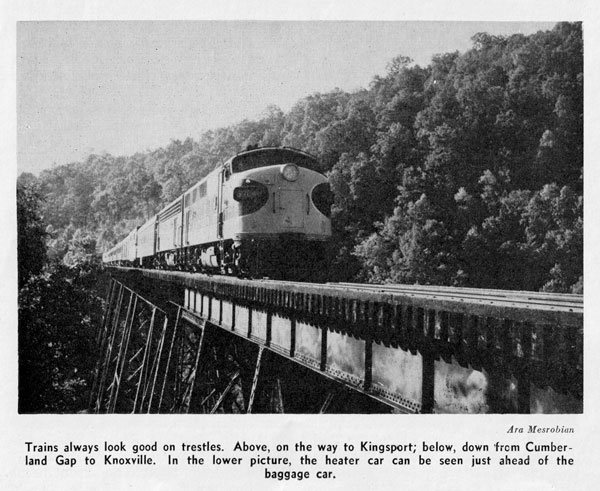 At Hagans we saw the junction where L&N coal trains turn away to reach Kentucky via Harlan and Baxter, and came to our picture stop, Rose Hill. There is a high spindly trestle at this point, and operating rules permit only one unit to be on the bridge at a time. So the order of the procession was (1) the first unit, (2) the photographers, and (3) the second unit with the train. We reached Cumberland Gap, junction with the Southern's line up from Knoxville and proceeded up the line to Middlesboro to wye the train - and the whole population was out to see the first passenger train in years. (But not too many years; until about eight years ago an L&N passenger train ran from Corbin, on the Cincinnati-Atlanta line, to Norton, Va., where a connection could be made for an N&W passenger train to Bluefield). In any event, we picked up the same units and rider car that had brought us up from Johnson City the previous day and headed south along the Southern to Knoxville, along the line which carried a Cumberland Gap-Corryton mixed until a few years ago. A movie run was made on a large trestle over a small stream, and we continued down a scenic valley into Knoxville.
At Hagans we saw the junction where L&N coal trains turn away to reach Kentucky via Harlan and Baxter, and came to our picture stop, Rose Hill. There is a high spindly trestle at this point, and operating rules permit only one unit to be on the bridge at a time. So the order of the procession was (1) the first unit, (2) the photographers, and (3) the second unit with the train. We reached Cumberland Gap, junction with the Southern's line up from Knoxville and proceeded up the line to Middlesboro to wye the train - and the whole population was out to see the first passenger train in years. (But not too many years; until about eight years ago an L&N passenger train ran from Corbin, on the Cincinnati-Atlanta line, to Norton, Va., where a connection could be made for an N&W passenger train to Bluefield). In any event, we picked up the same units and rider car that had brought us up from Johnson City the previous day and headed south along the Southern to Knoxville, along the line which carried a Cumberland Gap-Corryton mixed until a few years ago. A movie run was made on a large trestle over a small stream, and we continued down a scenic valley into Knoxville.
At Beverly, on the edge of the city, a belt line leads east into John Sevier yard, one of the most modern in the country, but our route lay south to a junction with the Knoxville-Harriman line at Coster, since we had a stop to make for train servicing at the Knoxville station. Here the Louisville Chapter left us; their sleeper was on Train 27, the Carolina Special and would be entered here. We met, first, Train 45, the Tennesseean, then Train 27, and, after a brief stop at Johnson City to discharge, made a fast mainline run in the dark to Bristol.
NRHS Bulletin / Fourth Quarter 1960
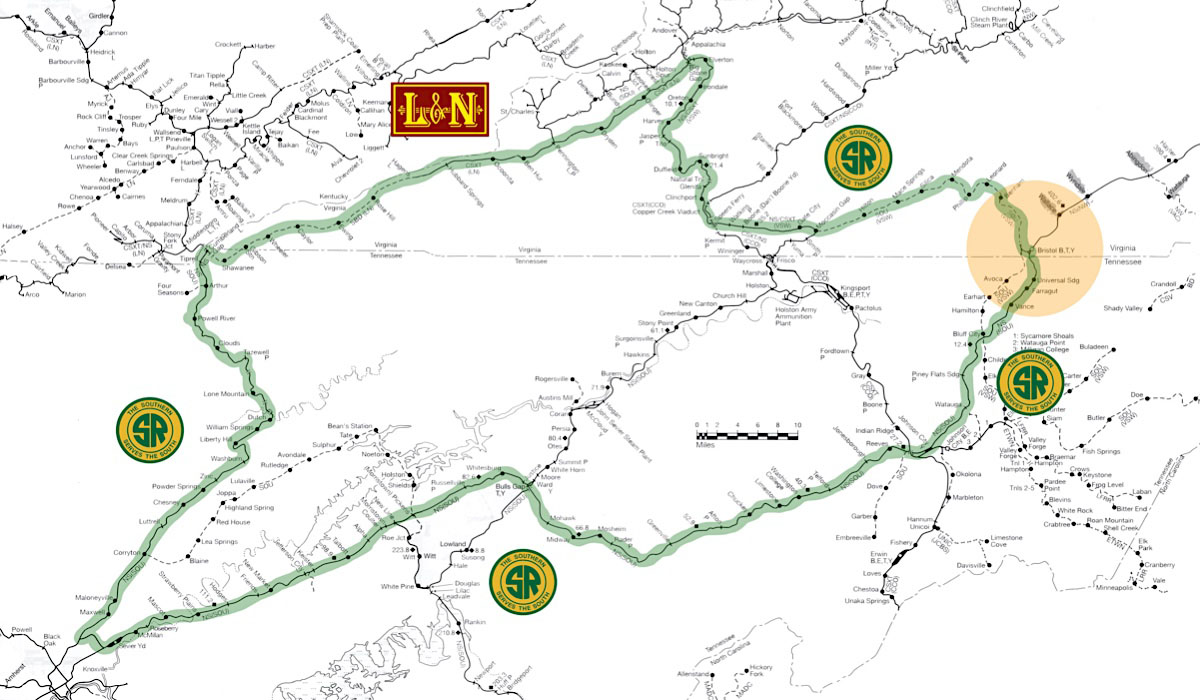
Sunday route map / RWH

Sep 1960 / JCH

Sep 1960 / JCH

Sep 1960 / JCH

See also our Southern Railway cab unit scrapbook in Mainlines
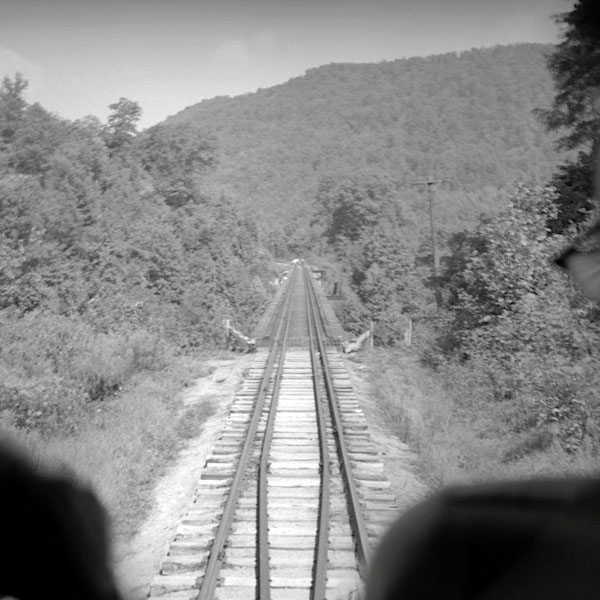
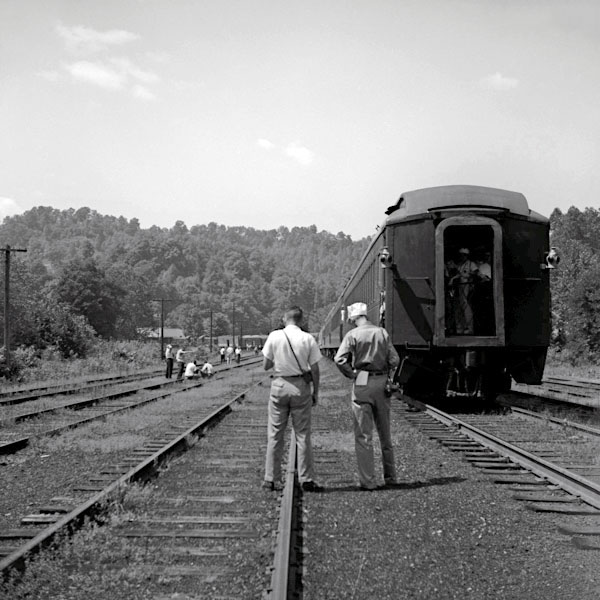
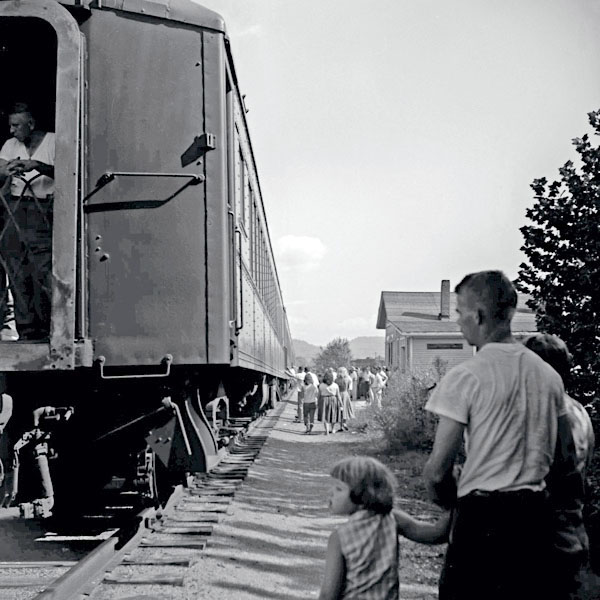
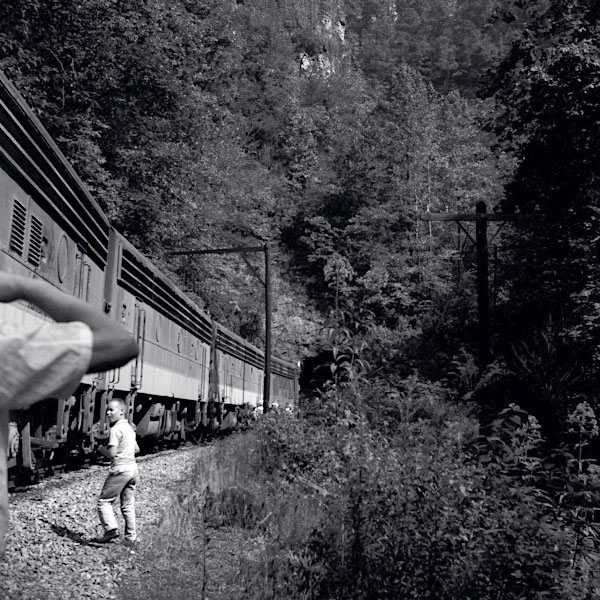
Sep 1960 / JCH
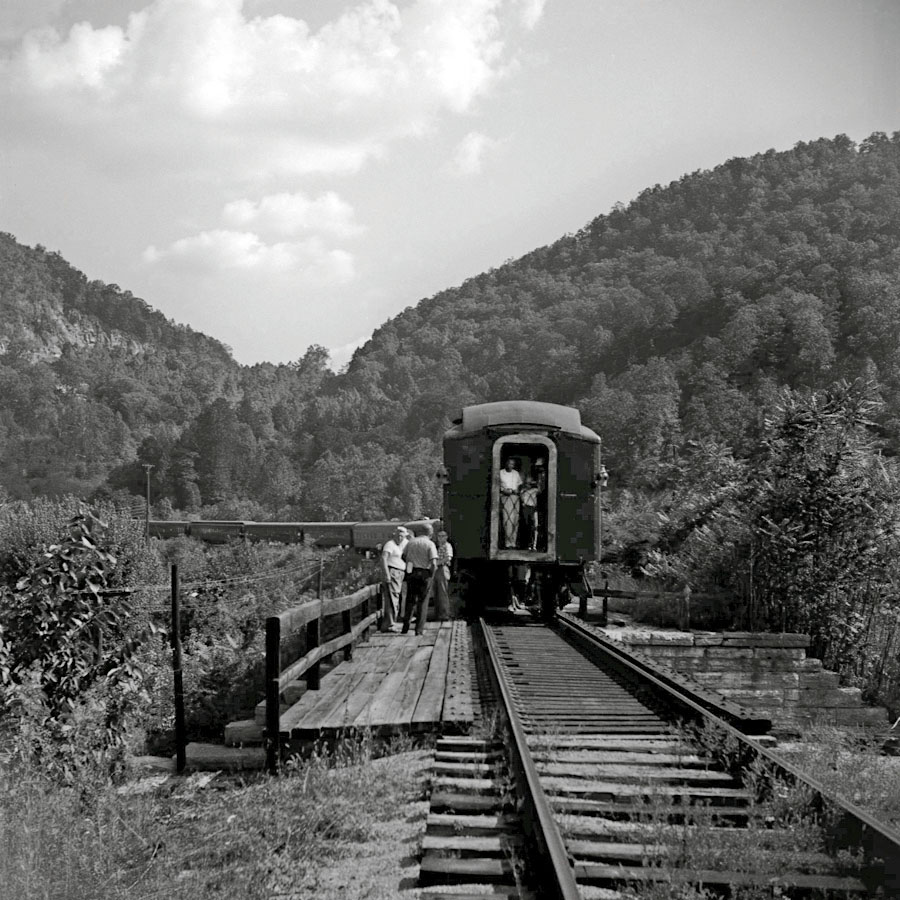
Sep 1960 / JCH
Monday

Monday's trip brought back steam. This time the train consisted of Norfolk & Western GP's 506 and 501, coaches 1672, 1705, 1655, 1648, baggage 129, and coaches 1647, 1669, 1663, and 1643. There was a delay in leaving because the gondolas had been spotted with the closed end facing the wrong way — a pardonable error; what switching crew ever heard of a single-ended gondola?
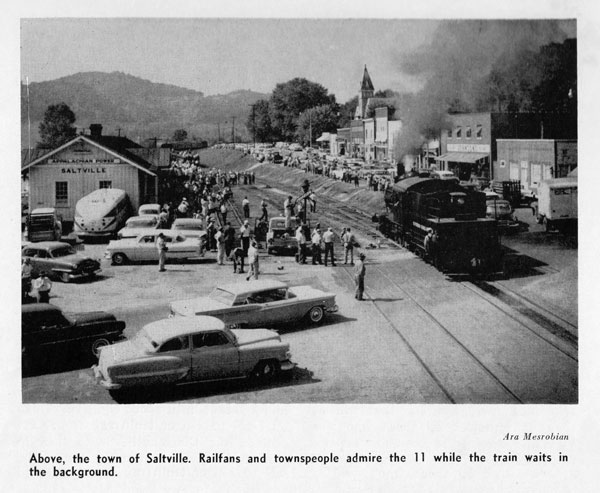 However, eventually the gons got on, and we headed east on the N&W main to Glade Spring, then west up the up-and-down branch to Saltville, where the Olin-Mathieson Chemical Corporation has a plant. Again, the whole town came out to greet us. On the freight station platform, the high school band, complete with pretty drum-major-ettes, played the overture, and then the star made her dramatic appearance. Around a bend came 2-8-0 number 11, leading a string of Olin Mathieson assorted freight cars and a caboose, lettered 1. A superb pillar of smoke came out of the 11's stack, spewing cinders impartially on photographers and drum-majorettes alike, but the band didn't miss a bar. Several times the train went back and forth; plenty of photographs for one and all. Having strutted and fretted her hour upon the stage, she came to rest in the middle of the yard, for those who wanted a closer look. Her builder's plate indicated she was built by Roanoke Machinery Works in June 1892 (now the N&W's Roanoke shops). She was formerly an N&W Class G, 300 series, although no one, to our regret, seemed to know her road number.
However, eventually the gons got on, and we headed east on the N&W main to Glade Spring, then west up the up-and-down branch to Saltville, where the Olin-Mathieson Chemical Corporation has a plant. Again, the whole town came out to greet us. On the freight station platform, the high school band, complete with pretty drum-major-ettes, played the overture, and then the star made her dramatic appearance. Around a bend came 2-8-0 number 11, leading a string of Olin Mathieson assorted freight cars and a caboose, lettered 1. A superb pillar of smoke came out of the 11's stack, spewing cinders impartially on photographers and drum-majorettes alike, but the band didn't miss a bar. Several times the train went back and forth; plenty of photographs for one and all. Having strutted and fretted her hour upon the stage, she came to rest in the middle of the yard, for those who wanted a closer look. Her builder's plate indicated she was built by Roanoke Machinery Works in June 1892 (now the N&W's Roanoke shops). She was formerly an N&W Class G, 300 series, although no one, to our regret, seemed to know her road number.
Eventually, the 11 took her last bows and the fans left town. Back at Glade Spring, coaches 1672 and 1705 were put on Train 46, the Tennesseean, for Washington; the rest of the train, including gons, headed back to Bristol, and the convention was over.
NRHS Bulletin / Fourth Quarter 1960
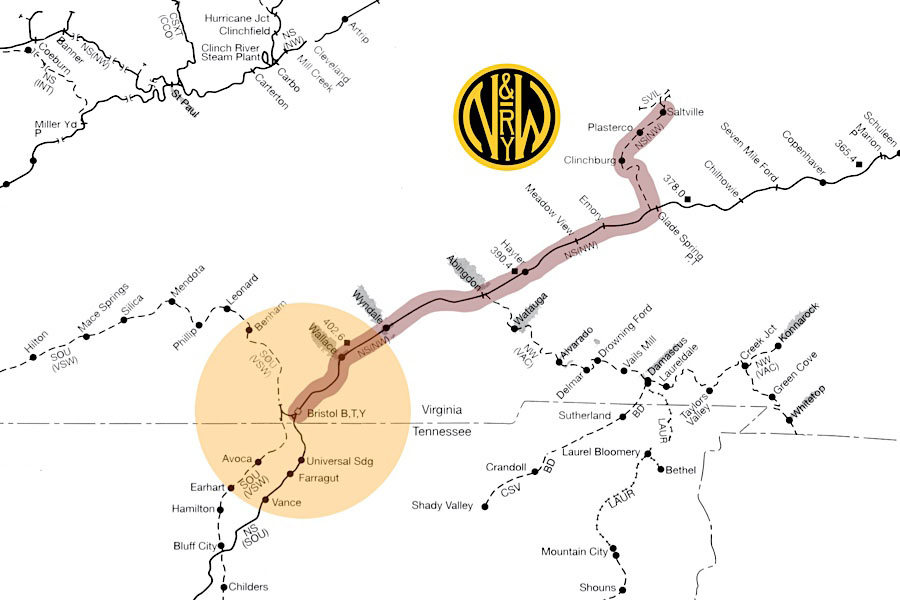
Monday route map / RWH

Saltville, Va / Sep 1960 / JCH
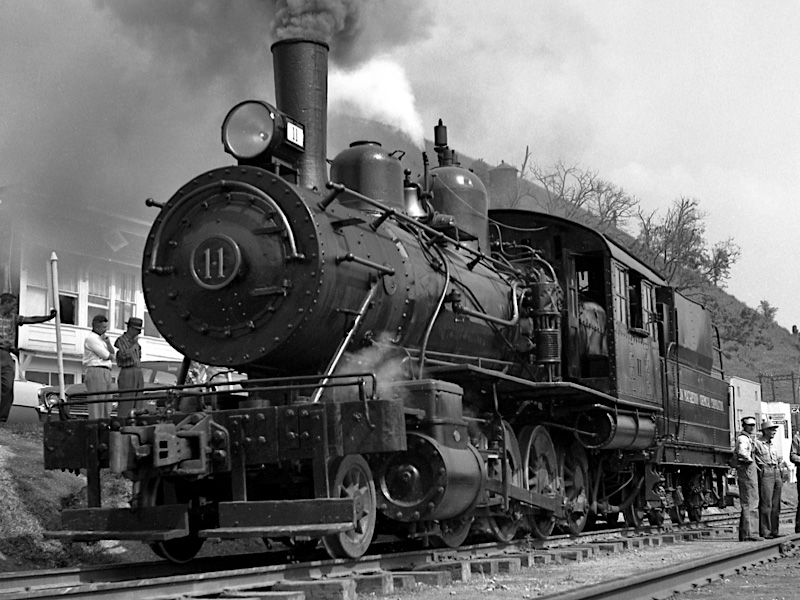
Olin Mathieson Chemical Corporation #11
Saltville, Va / Sep 1960 / JCH


Olin Mathieson Chemical Corporation #11
to Chesapeake & Western
to Mathieson Alkali Works #11
to Olin Mathieson Chemical Corp #11
to display in Saltville Va
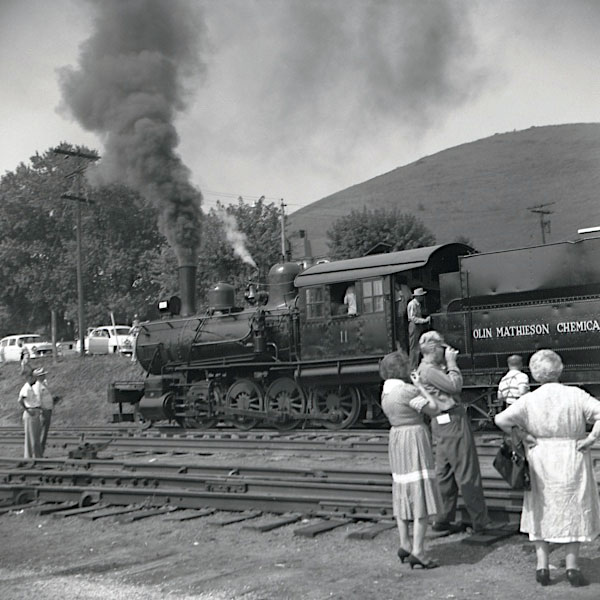
Saltville, Va / Sep 1960 / JCH
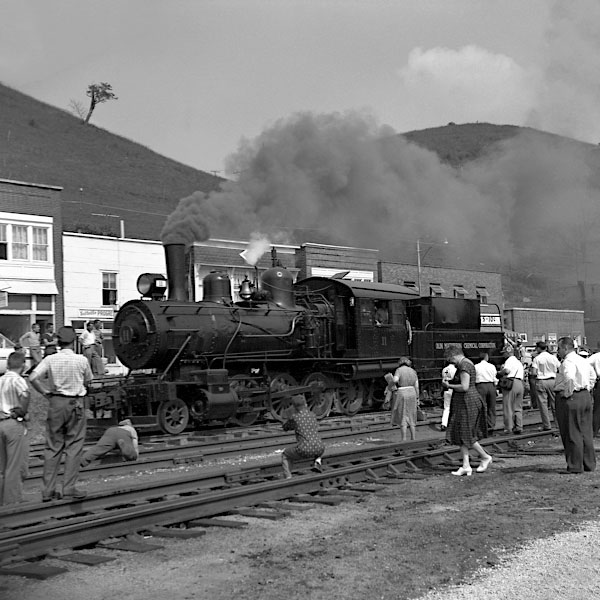
Saltville, Va / Sep 1960 / JCH
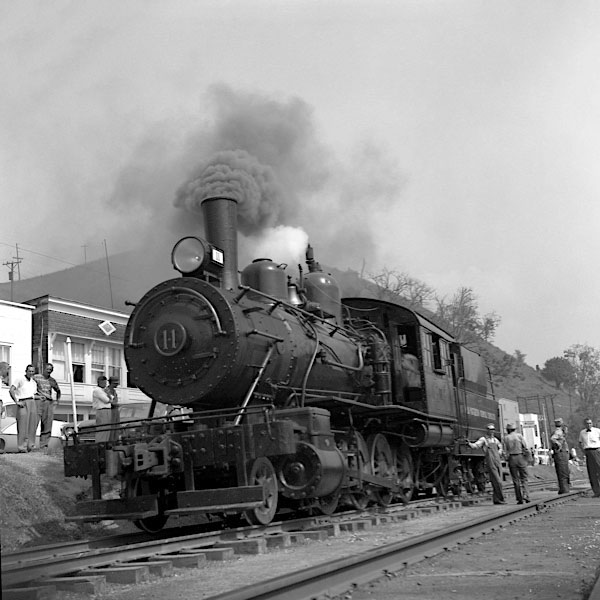
Saltville, Va / Sep 1960 / JCH

Saltville, Va / Sep 1960 / JCH
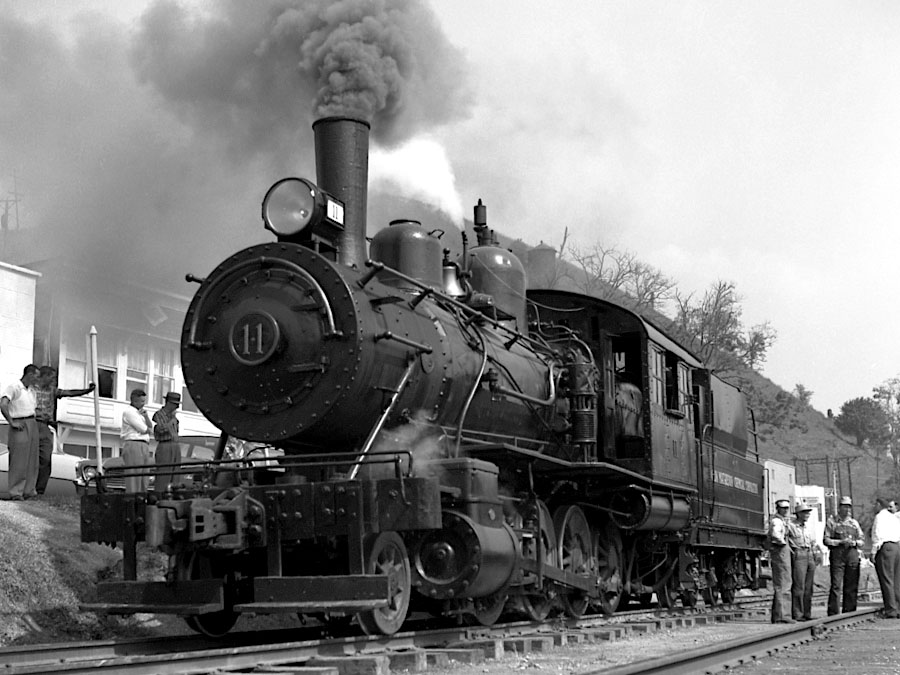
Saltville, Va / Sep 1960 / JCH

I attended the 1960 National Railway Historical Society convention in Bristol, Tenneesee. One of the day trips was up to Saltville, Virginia, where the Olin Mathieson Chemical Corp pulled out their ex N&W steamer #11. They pulled the steamer along in a short run-by with several chemical cars and their caboose. Townspeople were everywhere, and the local high school marching band played "I've Been Working on the Railroad." It was a grand day in Saltville!

Olin Mathieson Chemical Corp #1
wooden caboose / Saltville, Va / Sep 1960 / JCH

Saltville, Va / Sep 1960 / JCH
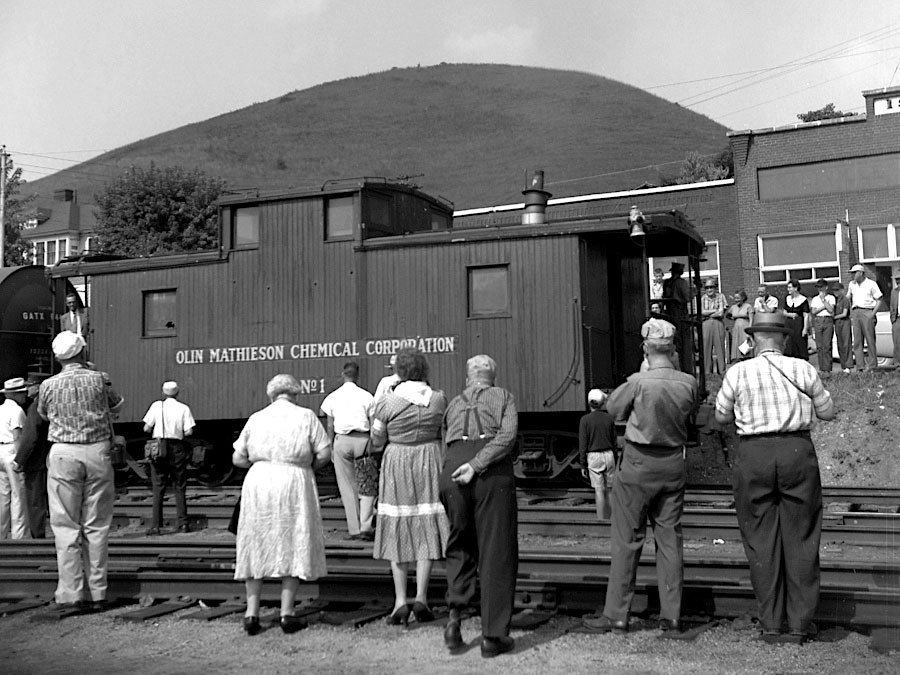
Saltville, Va / Sep 1960 / JCH

See also our complete Olin-Mathieson Chemical scrapbook in Industrials
 Clippings
Clippings
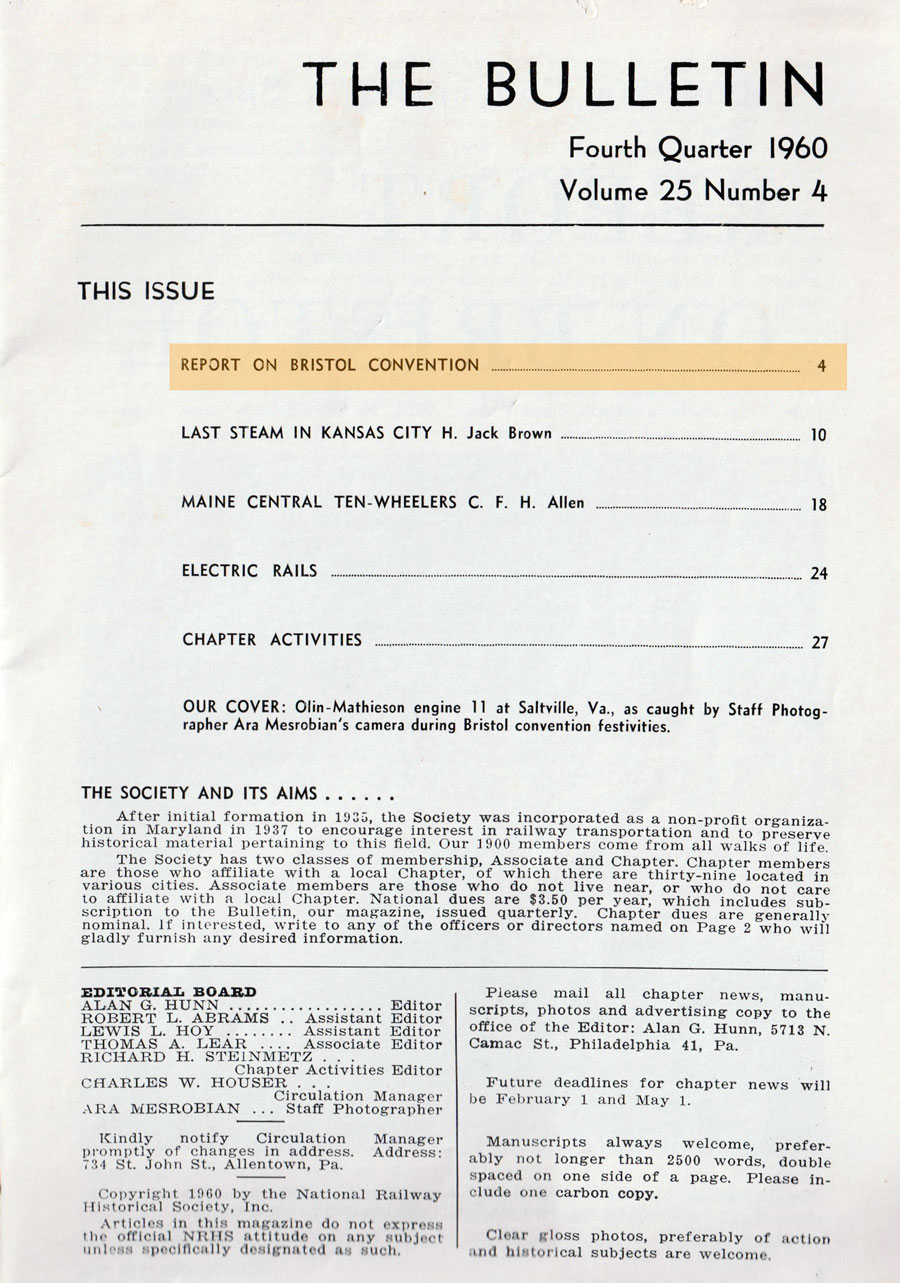
from NRHS Bulletin - Fourth Quarter 1960 / collection
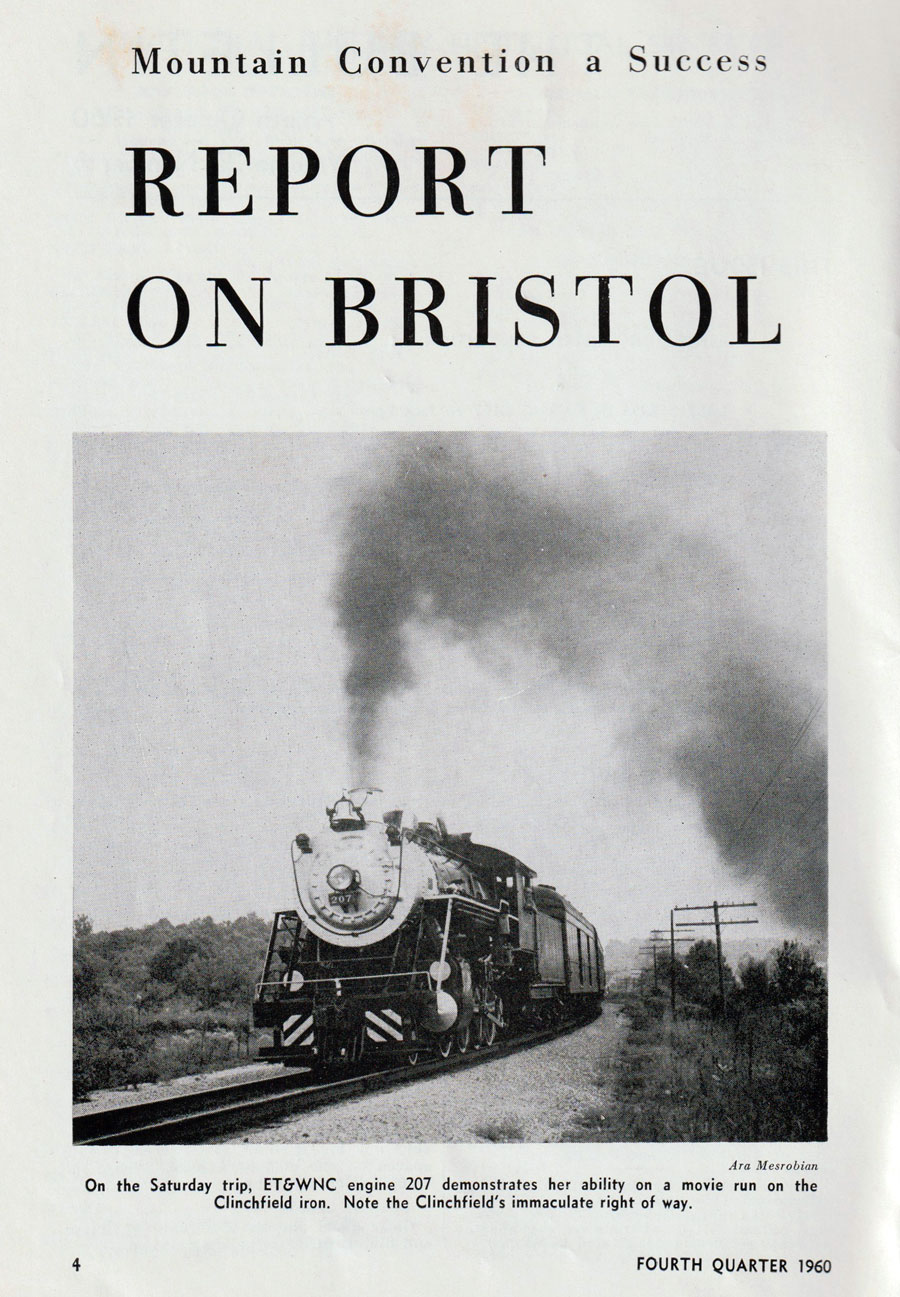
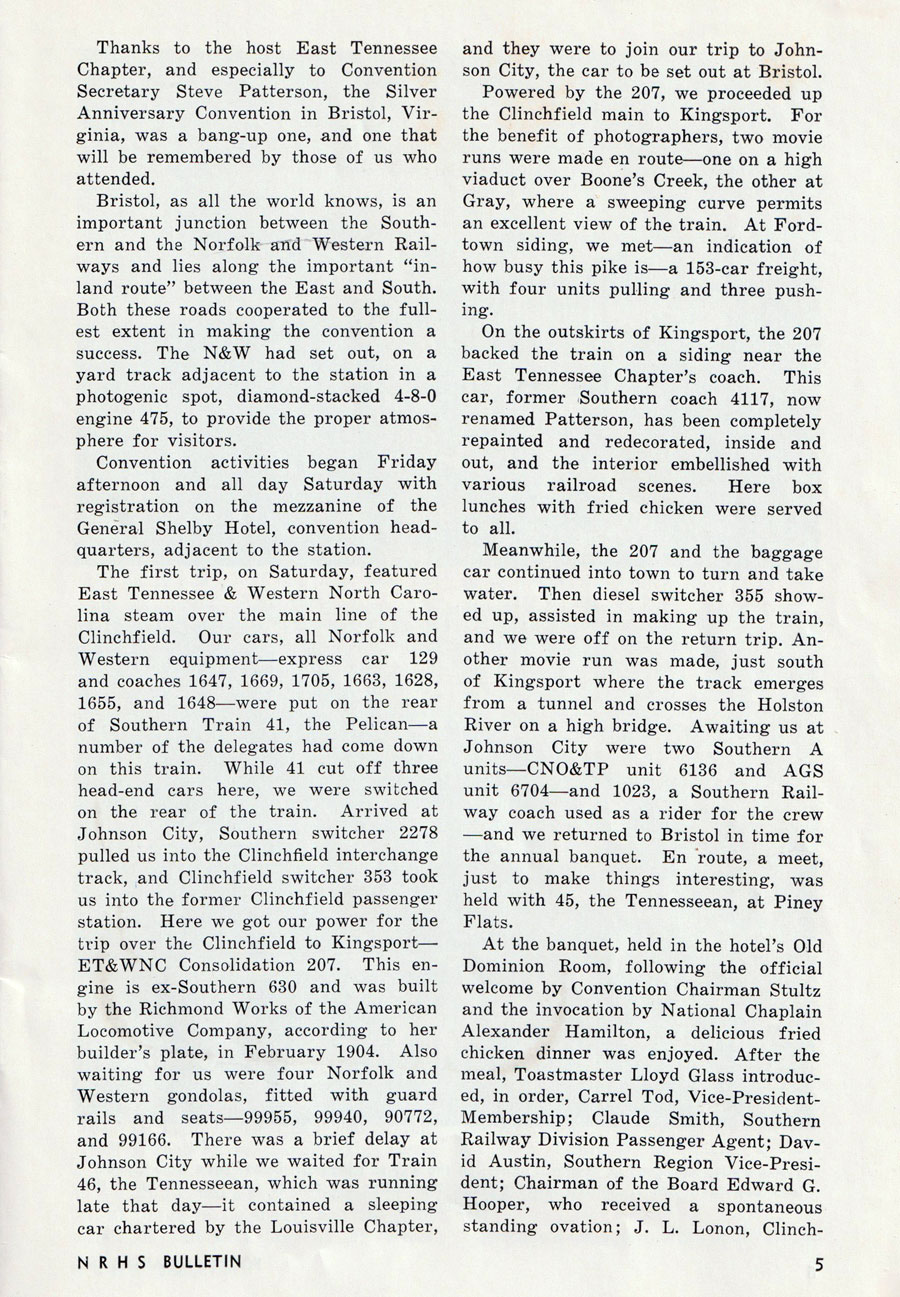
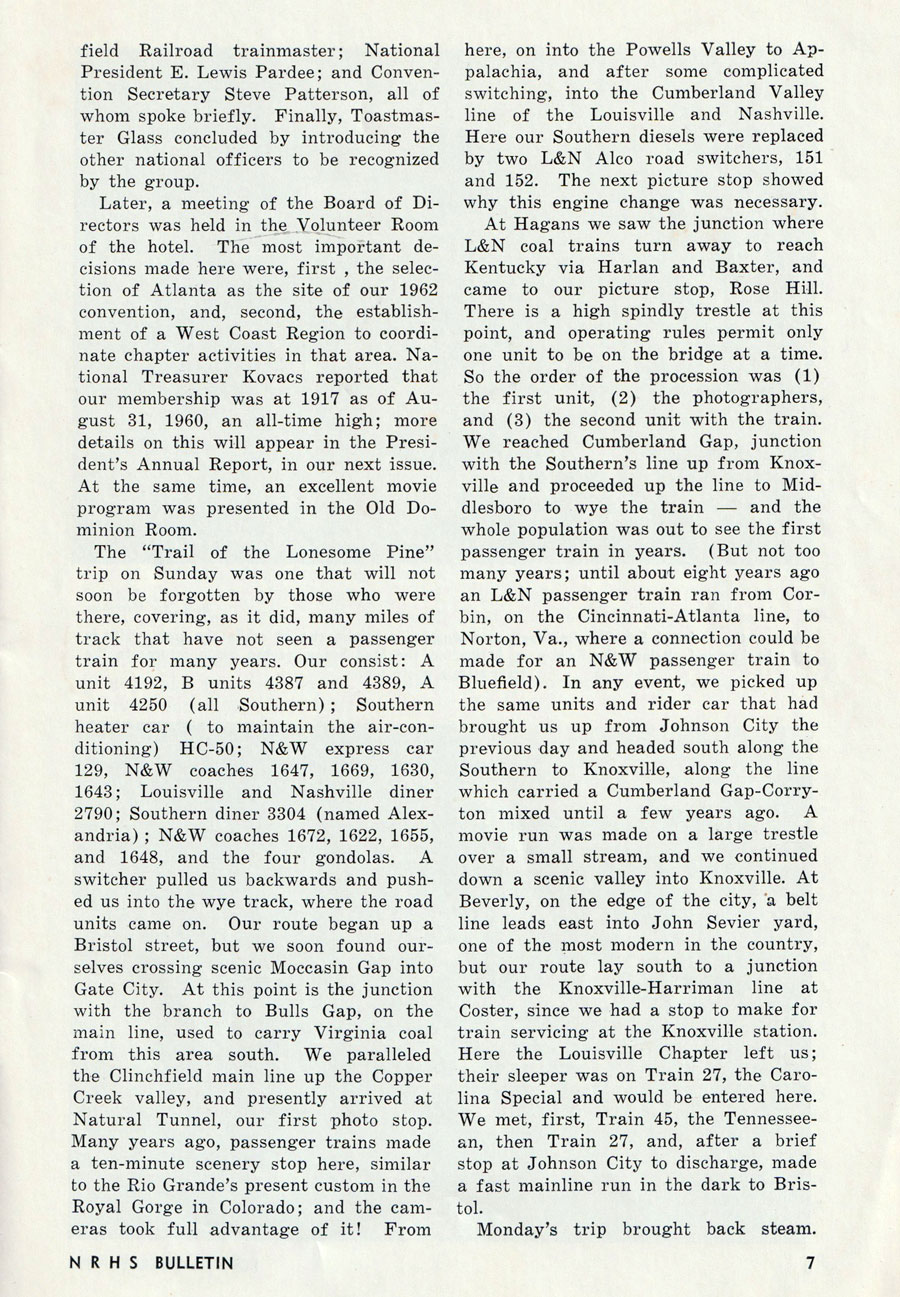

 Lagniappe
Lagniappe
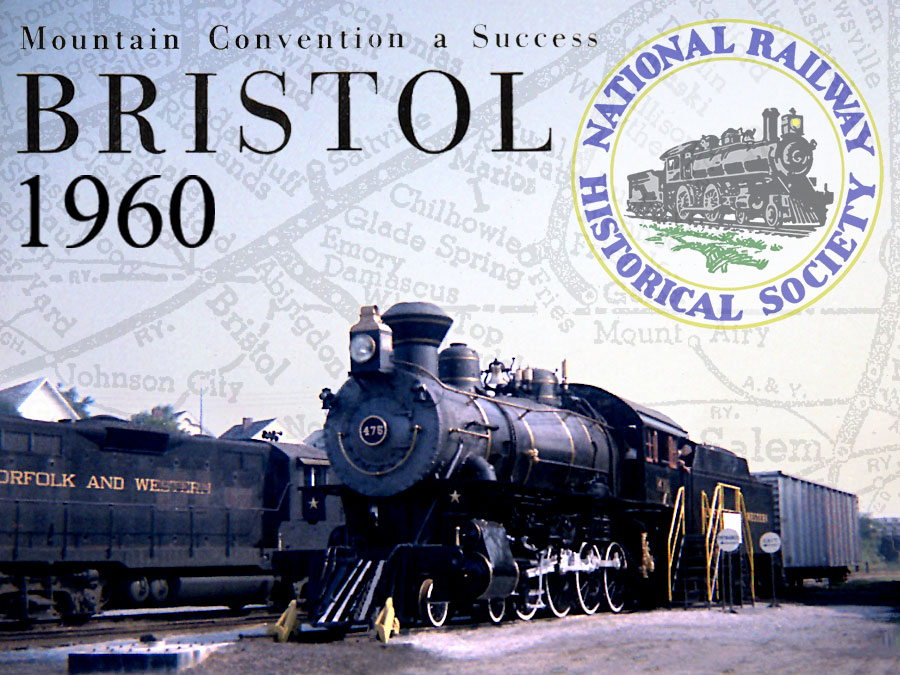
Society Success Story
Bristol, Va / image JCH / artwork RWH

Lookout Boys, I'm Comin' Through
Gray, Tn / Sep 1960 / JCH
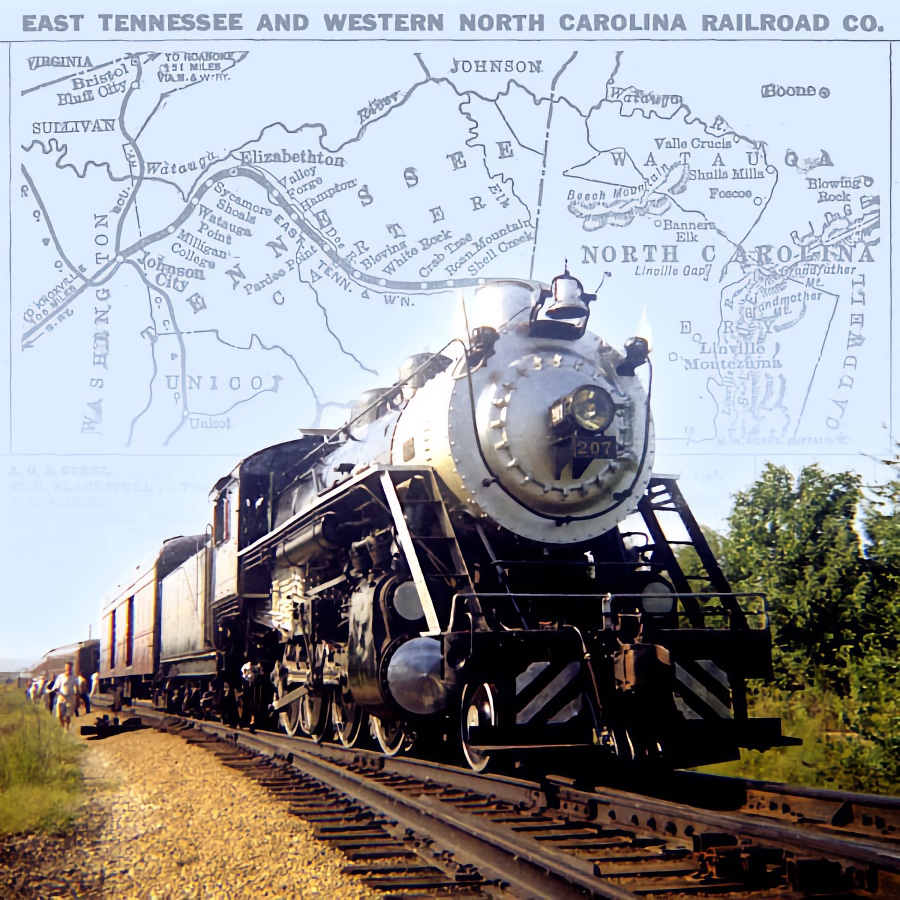
Eats Taters and Wears No Clothes
image JCH / artwork RWH
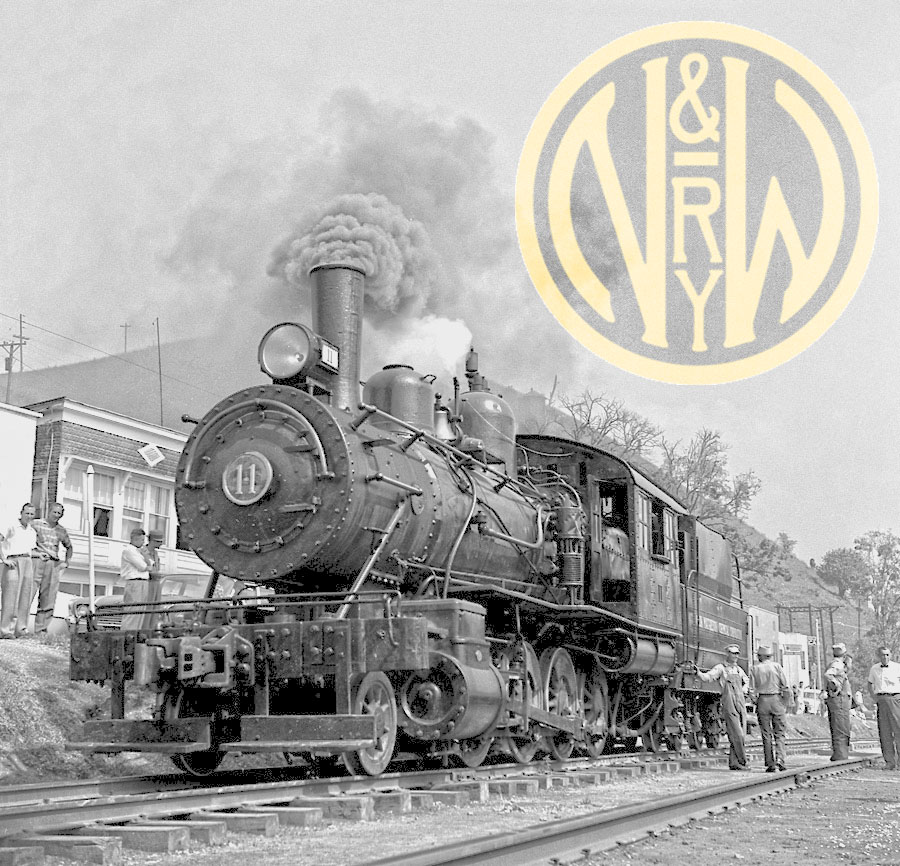
Roanoke Through and Through
Saltville, Va / image JCH / artwork RWH
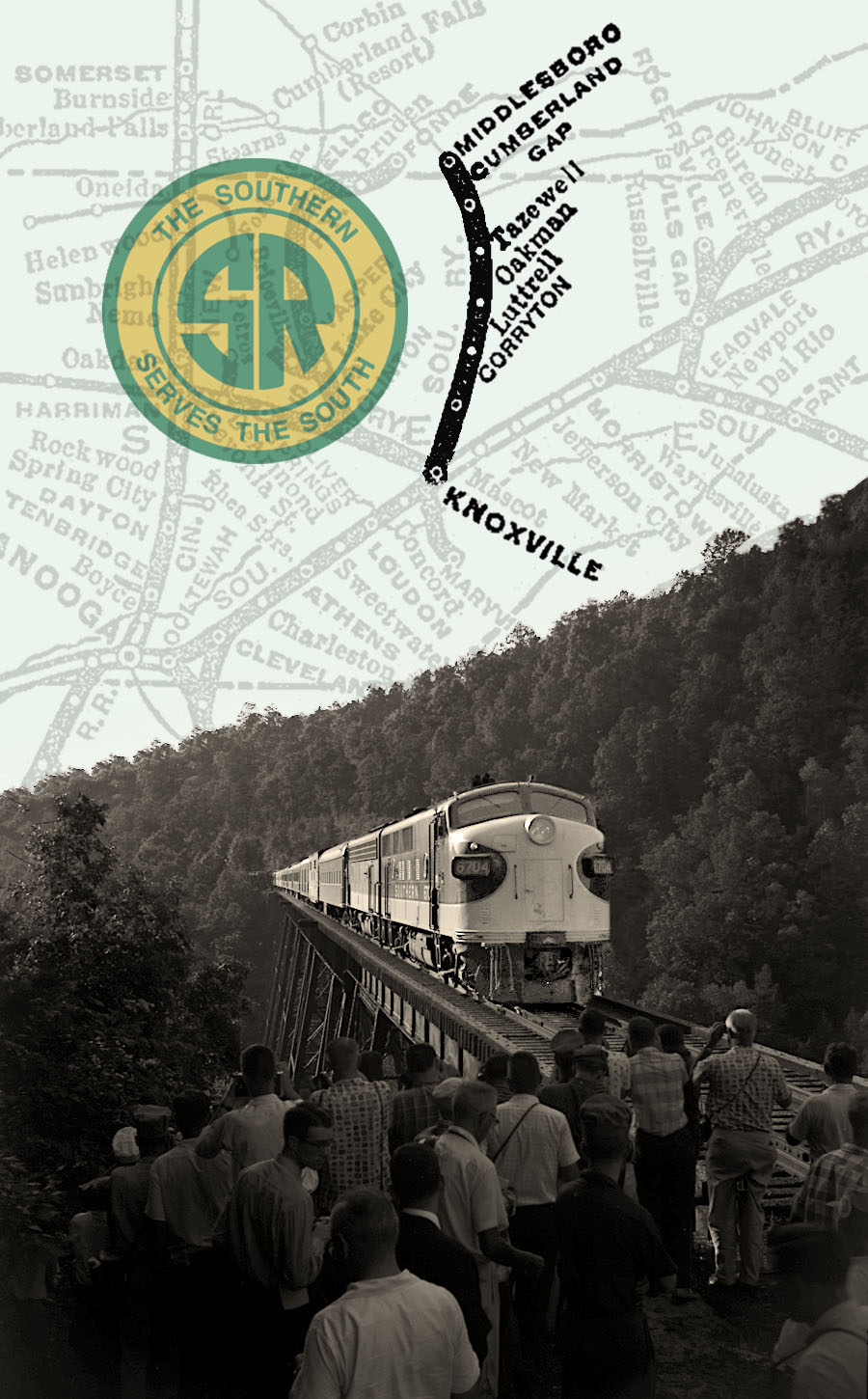
Coming Down from Cumberland Gap
Sep 1960 / image JCH / artwork RWH
